Get off the beaten track and visit Kyushu, Japan with your kids on a family holiday. Whether you want to get up close to a volcano or a feudal castle or dip your feet in volcanic water or ride a kids train, Kyushu is the place to go. This is Japan’s most southern mainland Island and was our favourite destination on our trip to Japan.
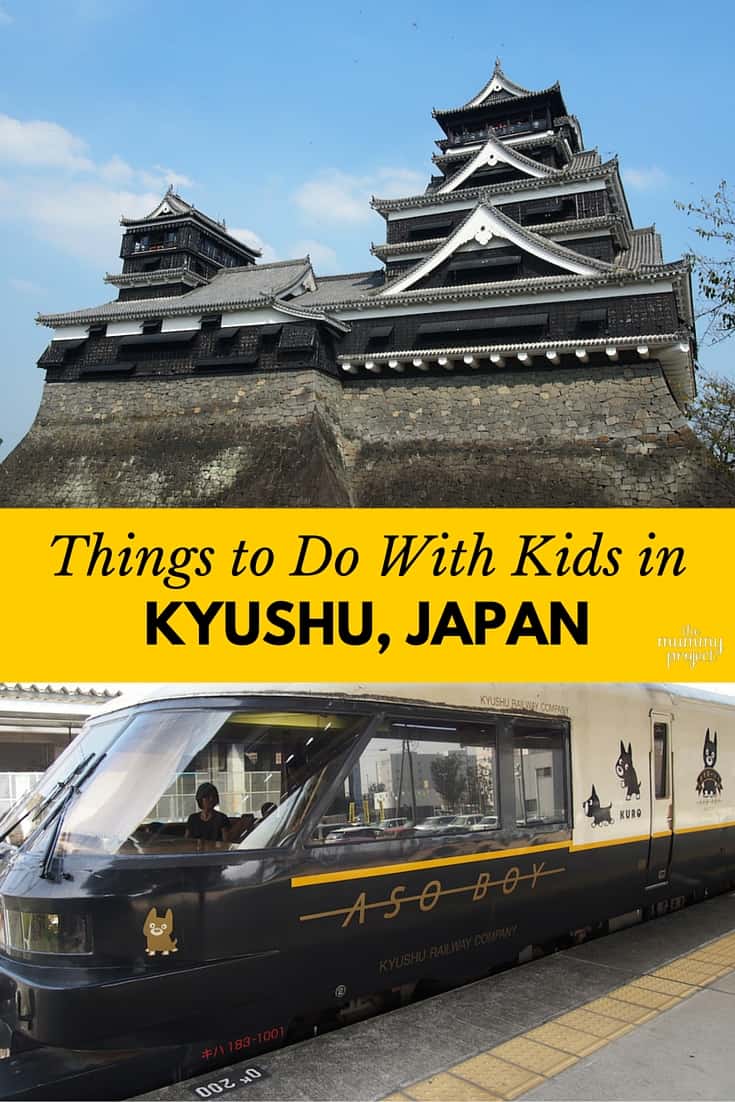
Kyushu with Kids
After leaving Hiroshima, we head to the city of Kagoshima dubbed the Playground of the South. Located on the southern tip of Japan, it is more than 1483 kilometres away from Tokyo. However, the completion of the Shinkansen bullet train line in 2011 means that the delights of Kyushu are easily accessible to Japanese and foreign visitors alike.
We’ve chosen to use the city of Kagoshima as a base to travel around Kyushu. We arrive in Kagoshima train station and immediately check into our hotel, the JR Kyushu Hotel Kagoshima. It’s conveniently located within the train station.
We start our Kyushu sightseeing in the town of Kunamoto, a 45 minute ride from Kagoshima by bullet train. We’ve heard about a scenic train heading to Mount Aso that’s geared to kids and we’re keen to give it a go. (JR Kyushu rail lines operate a number of specialty trains that are included at no extra charge for JR Pass holders)
We love trains and this one Aso Boy looks especially fun. It’s aptly named as asobouyo means ‘Let’s Play’ in Japanese. We reach the designated platform at Kunamoto Station and we immediately spot Aso Boy.

The train is covered with different pictures of Kuro, the JR Kyushu mascot.
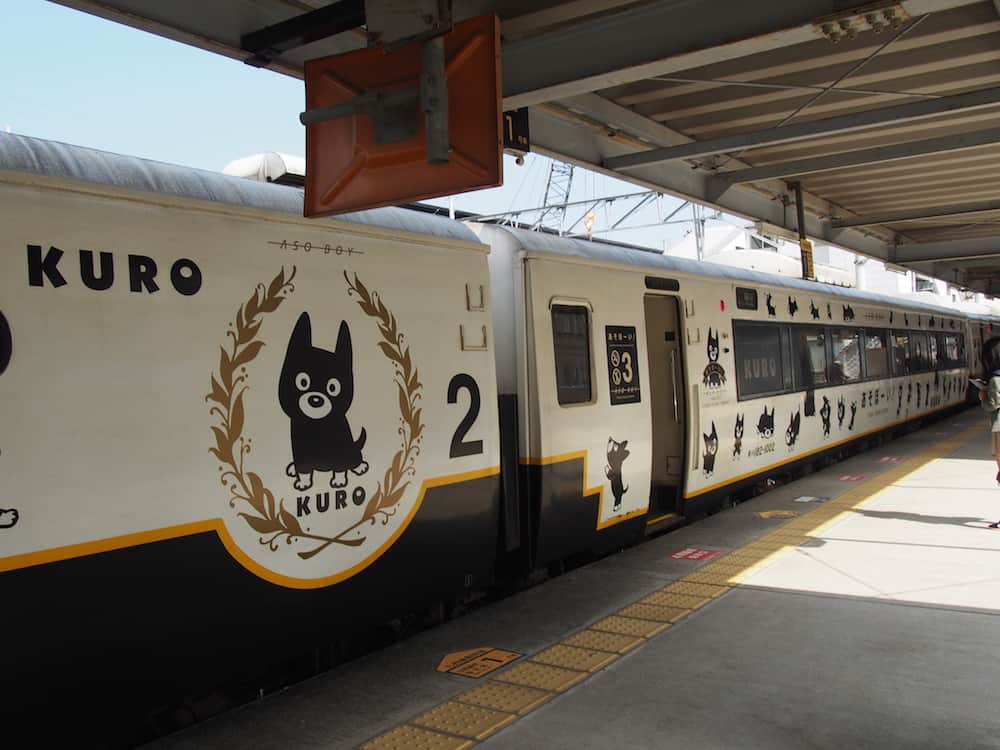
We clamber onto the train and the excitement builds. As we walk though the train, we marvel at the different seating styles all incorporating Kuro in some way.

We then discover Car 3 and my daughter squeals with delight.
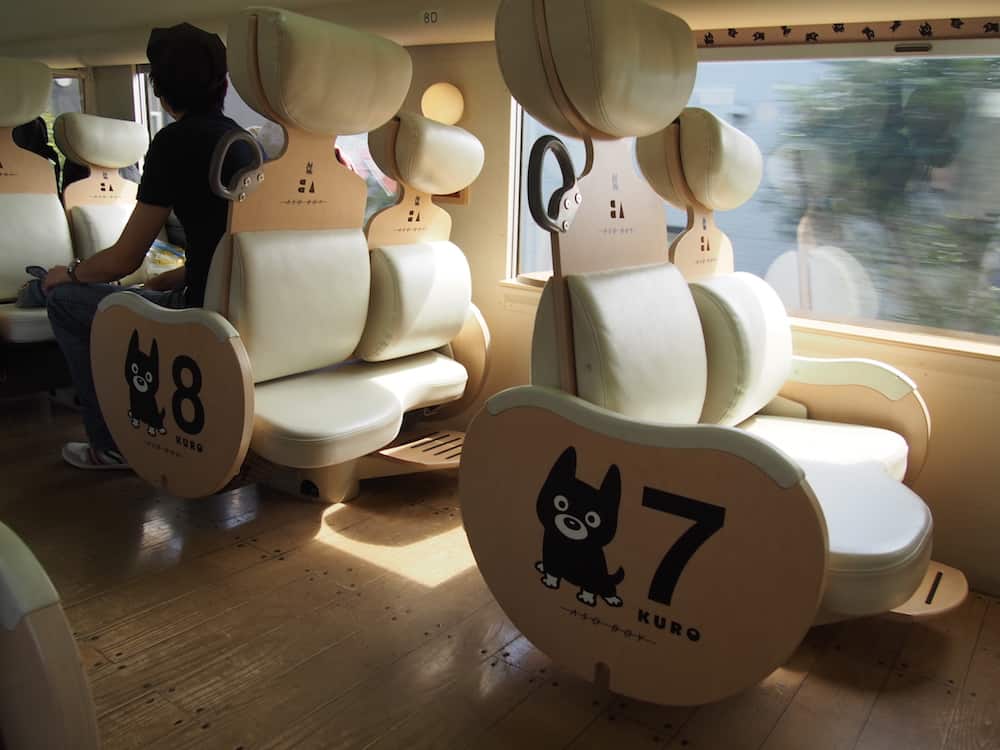
This is the family carriage and features specially designed adult and kids seats, a kids ball pit area, children’s library and attendants that amuse and entertain your kids. As soon as the train departs the station, kids immediately jump into the pool full of small wooden balls and start playing.

They are having a ball, pun intended!
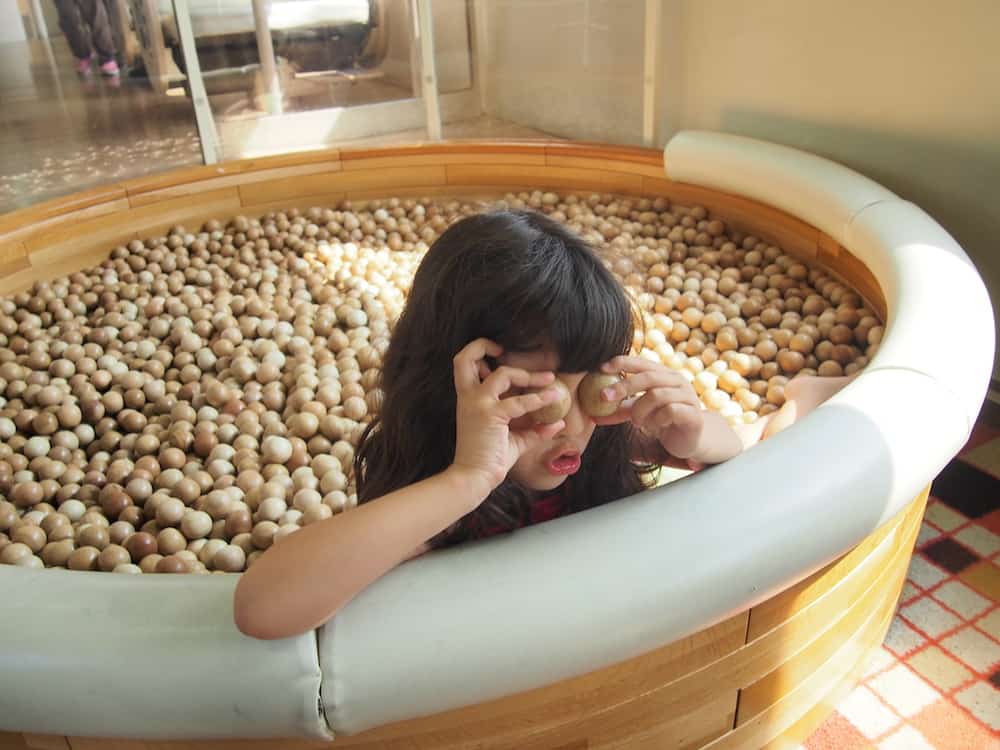
There’s a lovely cabin attendant clad in a special Kuro uniform who watches over and plays with the kids. This patient woman reads children’s books in both Japanese and in English and shows them how to fold origami.

It’s an educational experience for my child who learns a few phrases of Japanese while making origami puppies and then promptly teaches her new Japanese friends some English. She also invites them to our house in Australia. How’s that for promoting cross-cultural diplomacy, kid style?
It’s then time for the obligatory photo with the train placard.
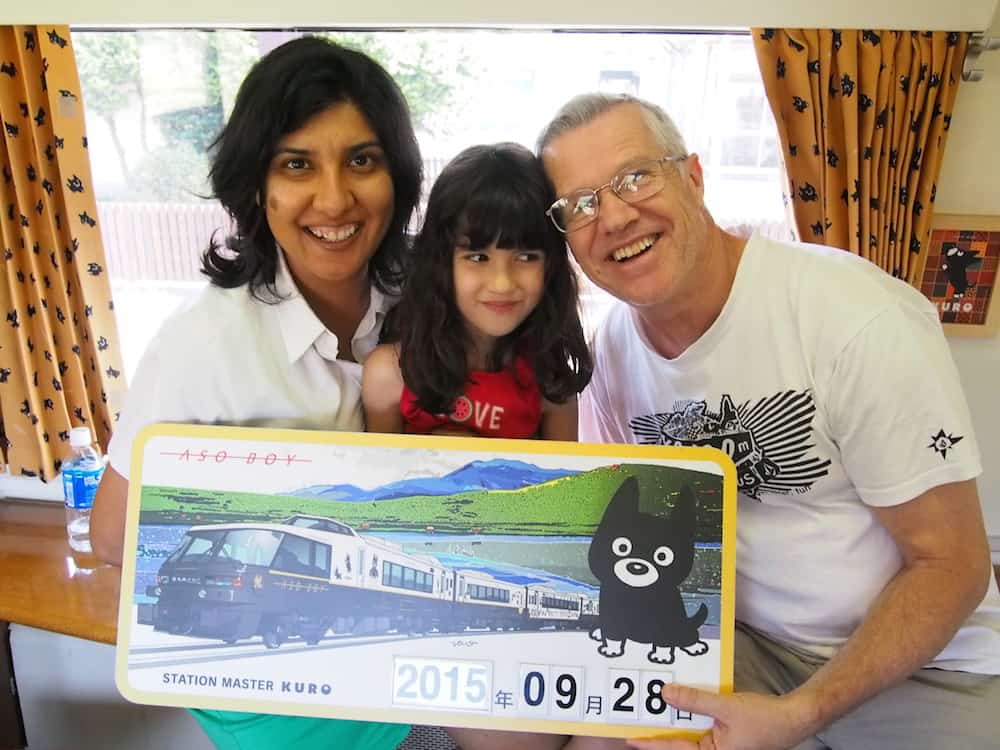
There’s also a library located next to the ball pit which contains different pictures book for kids to read.
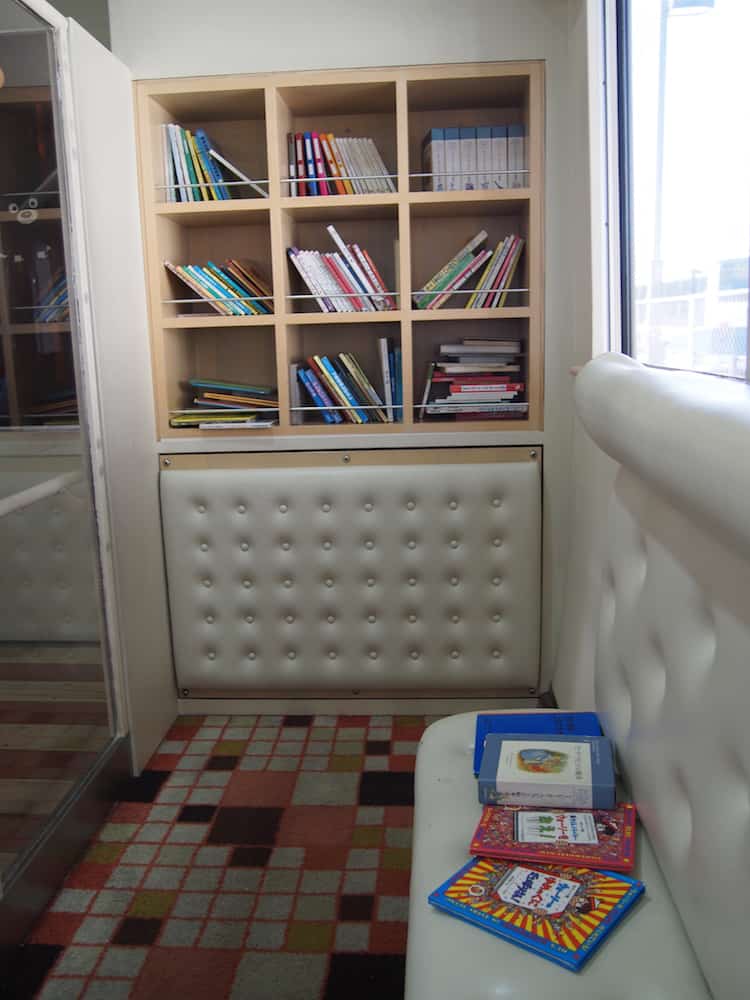
We pick up a selection of familiar books like Where’s Spot and Peter Rabbit and marvel at the Japanese text. We find a copy of Where’s Waldo as well which doesn’t require any Kanji language skills to decipher.

After reading for a while, we it’s time to visit the Kuro Cafe to purchase some snacks and Kuro souvenirs.
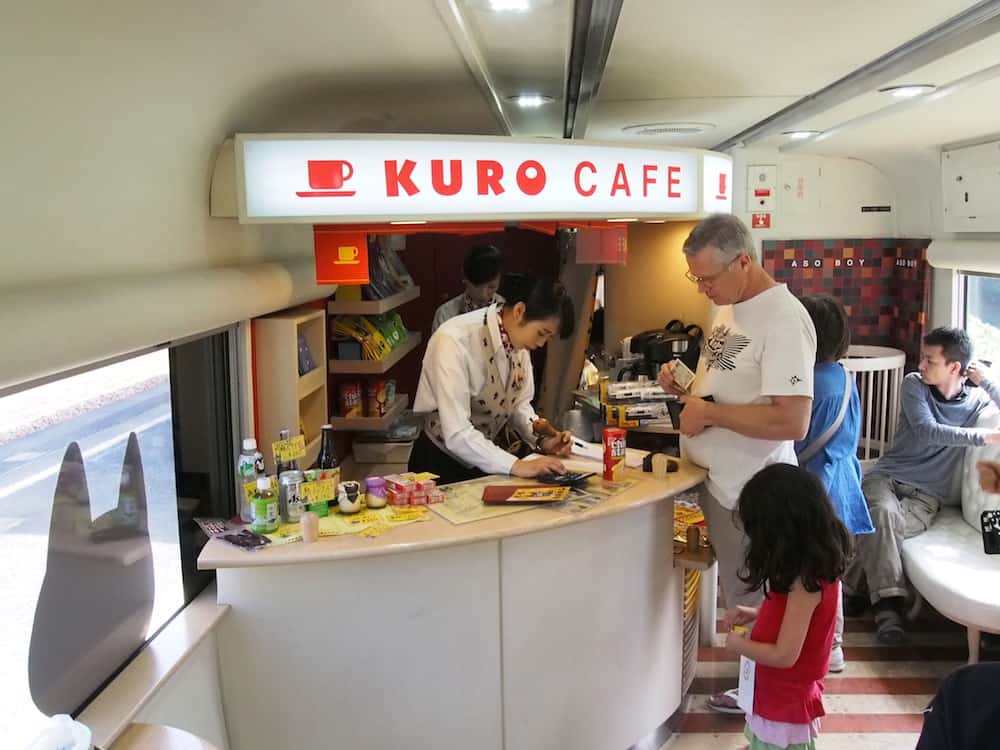
After snacktime, my daughter returns to playing with her new friends and my husband and I gaze out of the window. Our journey to Mount Aso begins with a series of switchbacks to climb up a steep gradient. It’s not long until we are informed that we are in the caldera which covers an area of 350 square metres.

A caldera is a large depression which has been created by a volcano over a series of eruptions. The Mount Aso caldera is one of the largest in the world which provides an indication of the power and frequency of this volcano’s eruptions. From here, we can see one of the volcanic cones of Mount Aso and it’s impressive.
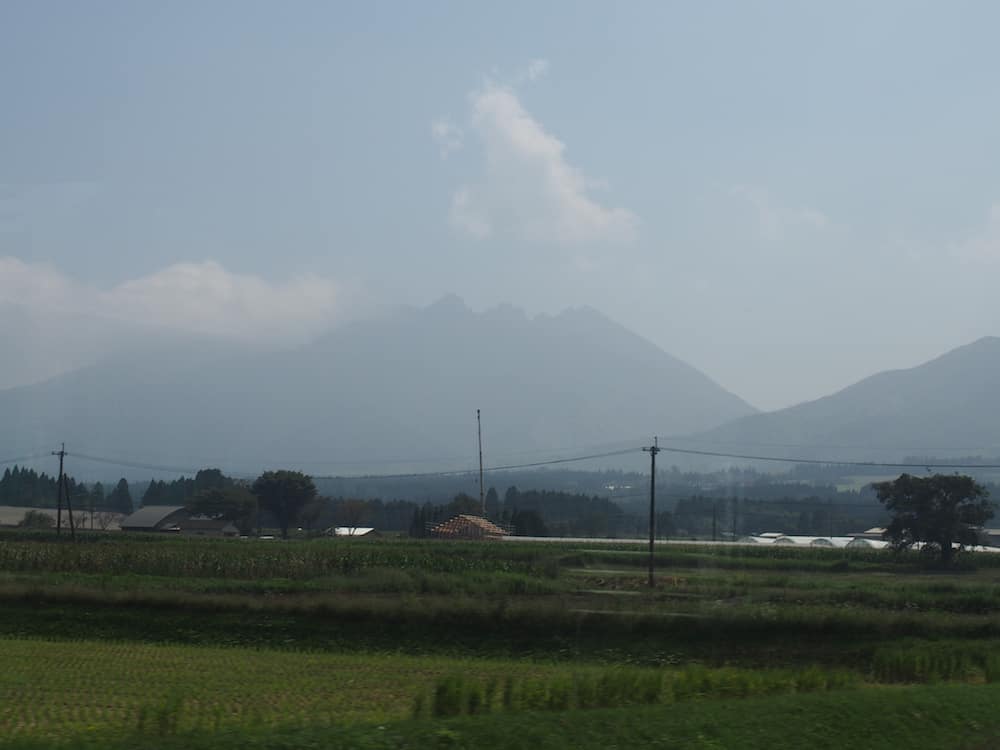
After an hour and a half, the train stops at Aso station. Most of the other passengers depart to take the bus to Mount Aso. However, we decide to forgo the experience as tourists are limited in how close they can get to Mount Aso, the largest active volcano in Japan.
The Mount Aso ropeway which takes visitors to the craters edge has been shut down indefinitely due to an eruption the previous month and subsequent seismic activity. The volcano also spews out noxious gas on a regular basis. We instead hang around the station and find Kuro’s kennel before embarking on the train for its return back to Kumamoto.
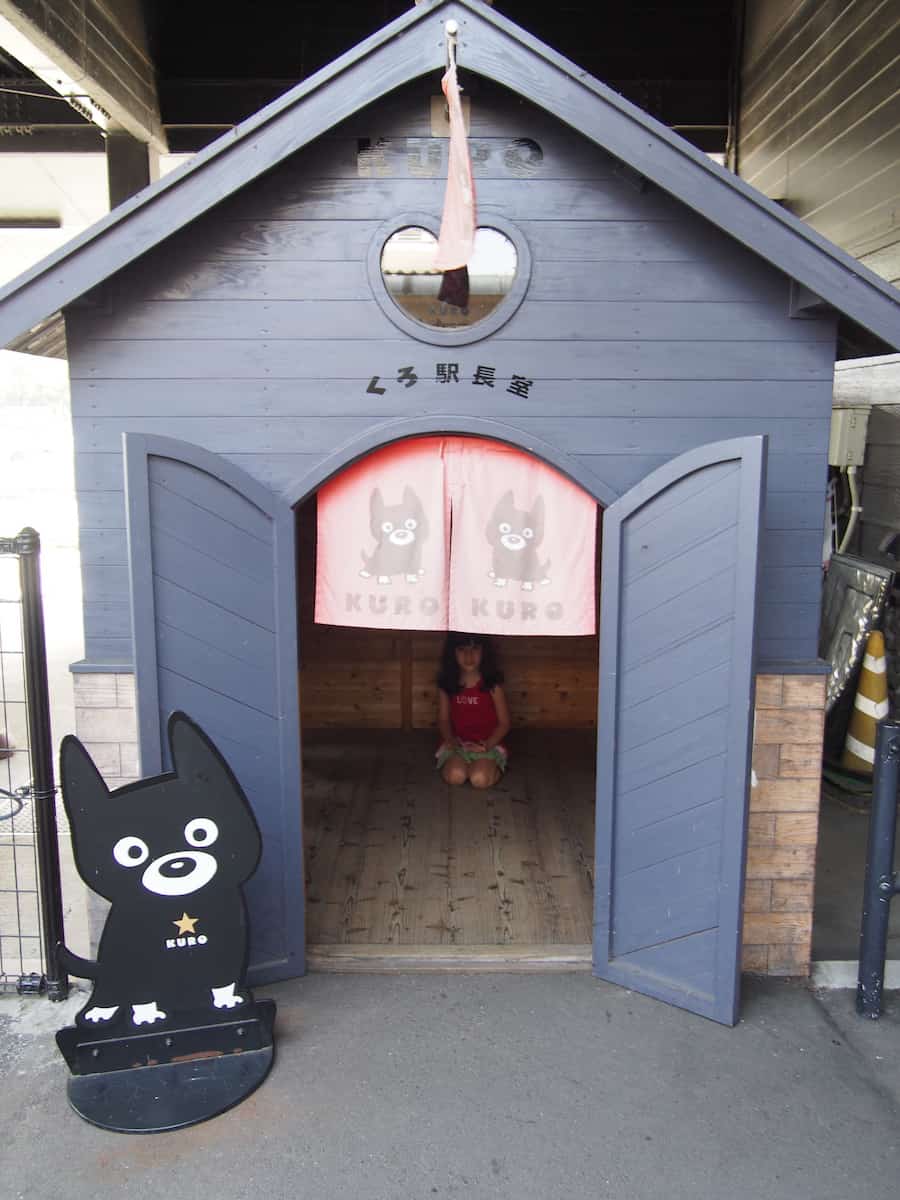
Once back in Kumamoto, we decide to stop and visit the famed Kumamoto Castle. It’s easy to reach with the tourist shuttle Kumamoto Castle Loop Bus which visits the castle as well as other tourist sites.
UPDATE: Kumamoto Castle was damaged in an earthquake in 2016. However, you can still visit the castle which is being restored via a temporary observation pathway.
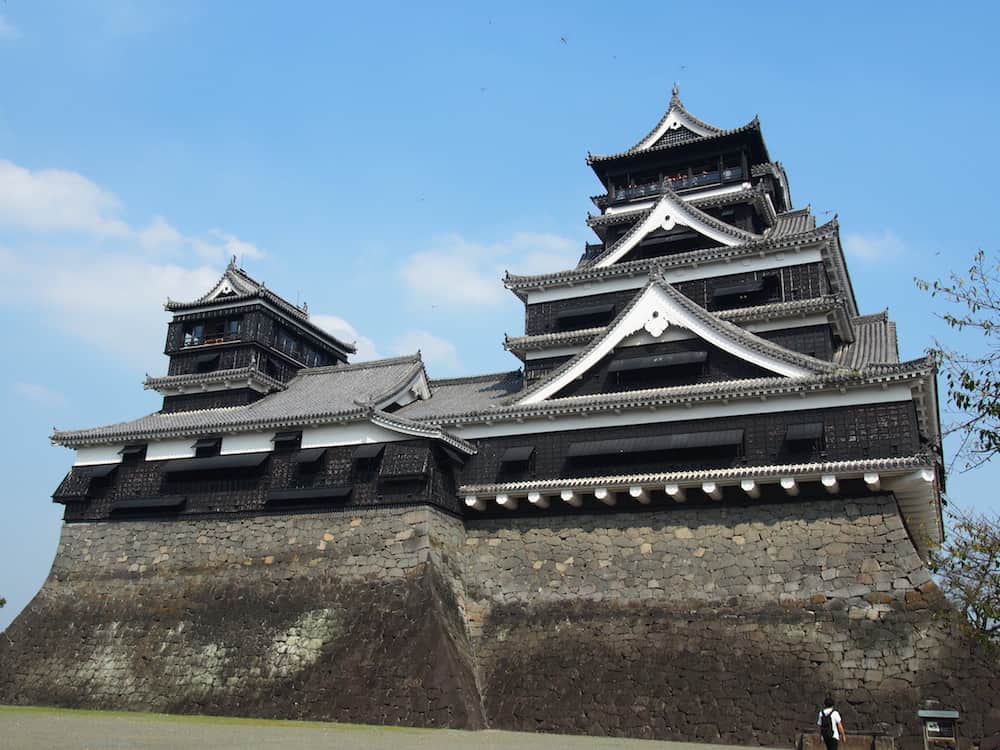
Kumamoto Castle, Japan’s third-largest castle, is a remarkable structure completed in 1607. As we enter the castle, we notice the high walls designed to prevent intruders. To access the castle, we have to go through an underground passage known as The Passage of Darkness where we keep expecting ninjas to jump out at us.
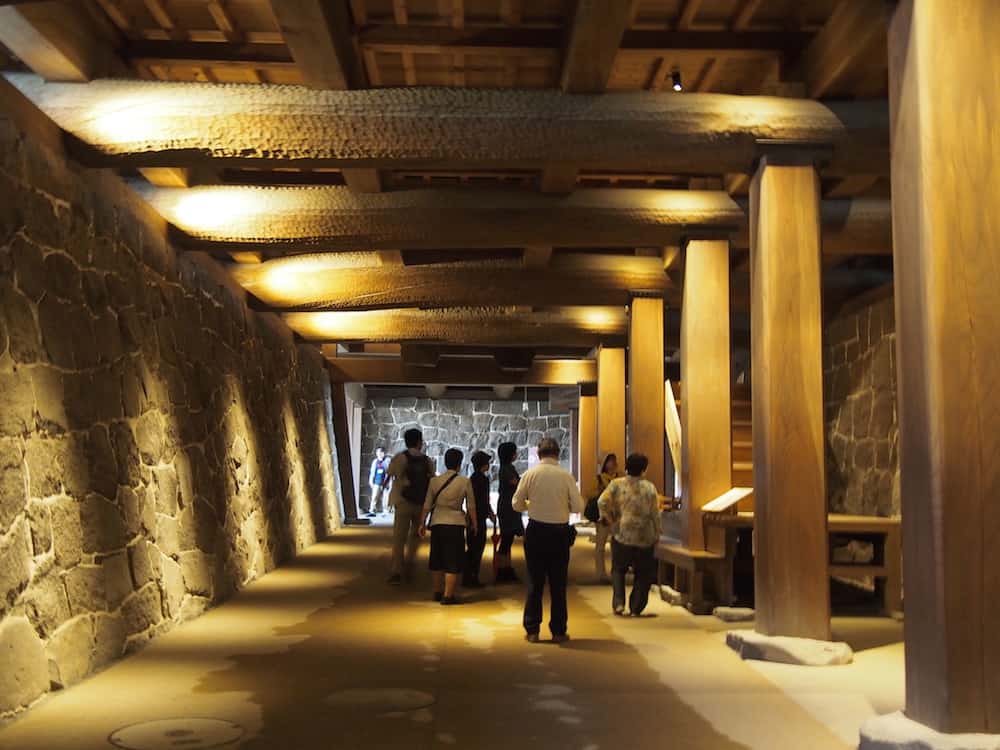
We don’t see any ninjas but we do spot Japanese warriors entertaining the crowds with sword display as we emerge.
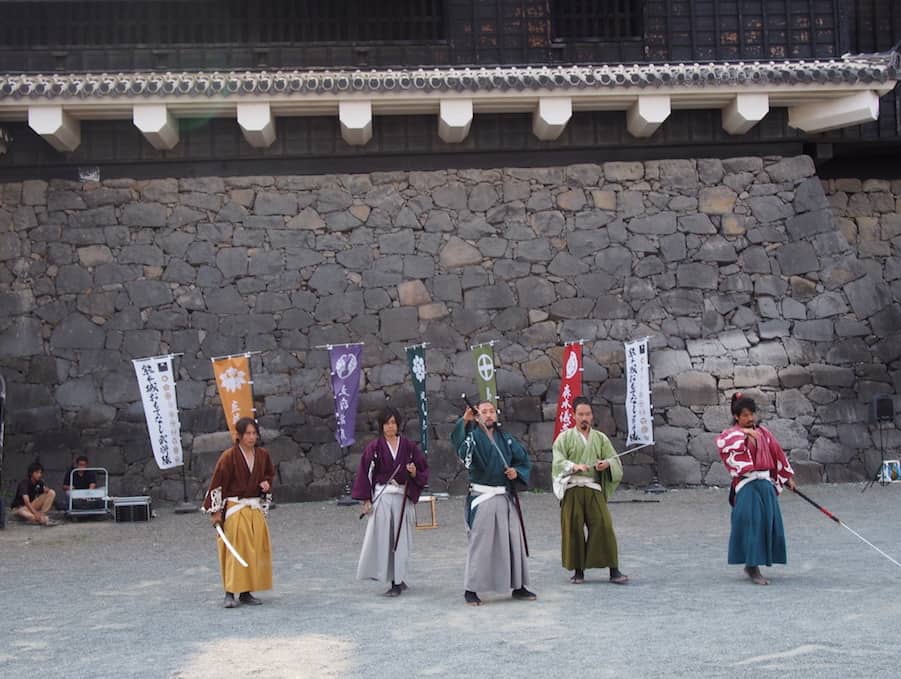
My daughter is enjoying herself immensely which is a relief. We weren’t sure if a feudal Japanese castle would keep her interested but apparently it does. She’s fascinated by the castle and is keen to climb up to the top of Uto Turret. Although much of the castle was destroyed in 1877 by a group of samurai, it was reconstructed in 1960. However, there are original buildings dating back to 1607. This includes the three-tiered, five-storey Uto Turret.
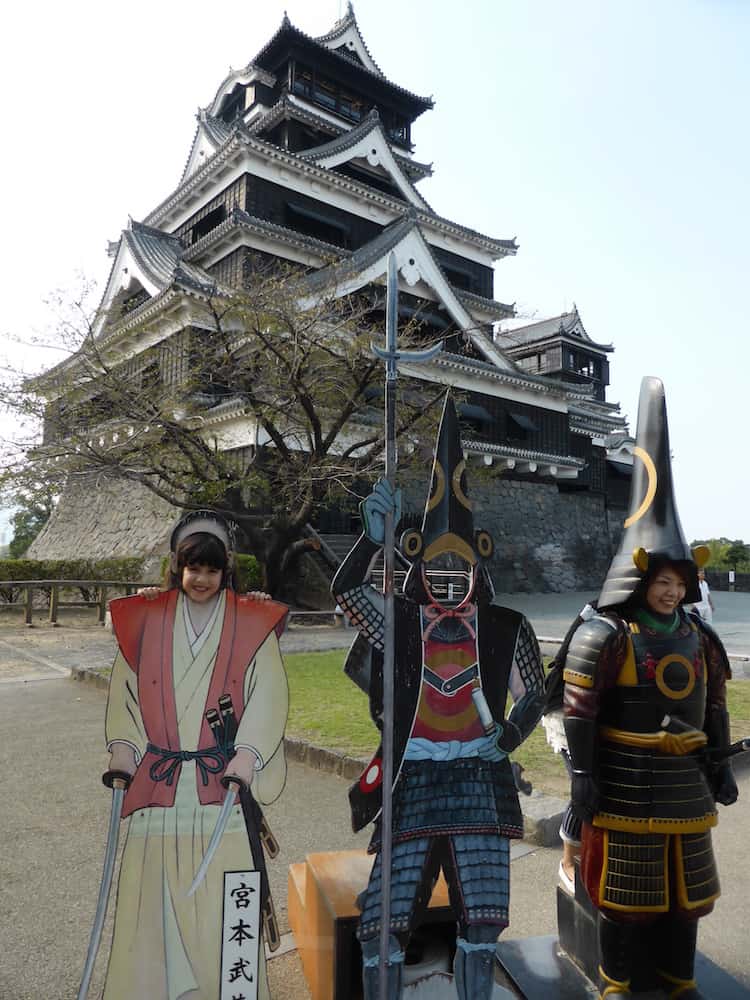
A wooden staircase takes us from ground level to the top, a distance of five stories. We stop on each floor to read the interesting history panels but eventually, we reach the top. From here, there are views all around Kumamoto including the expansive castle grounds.
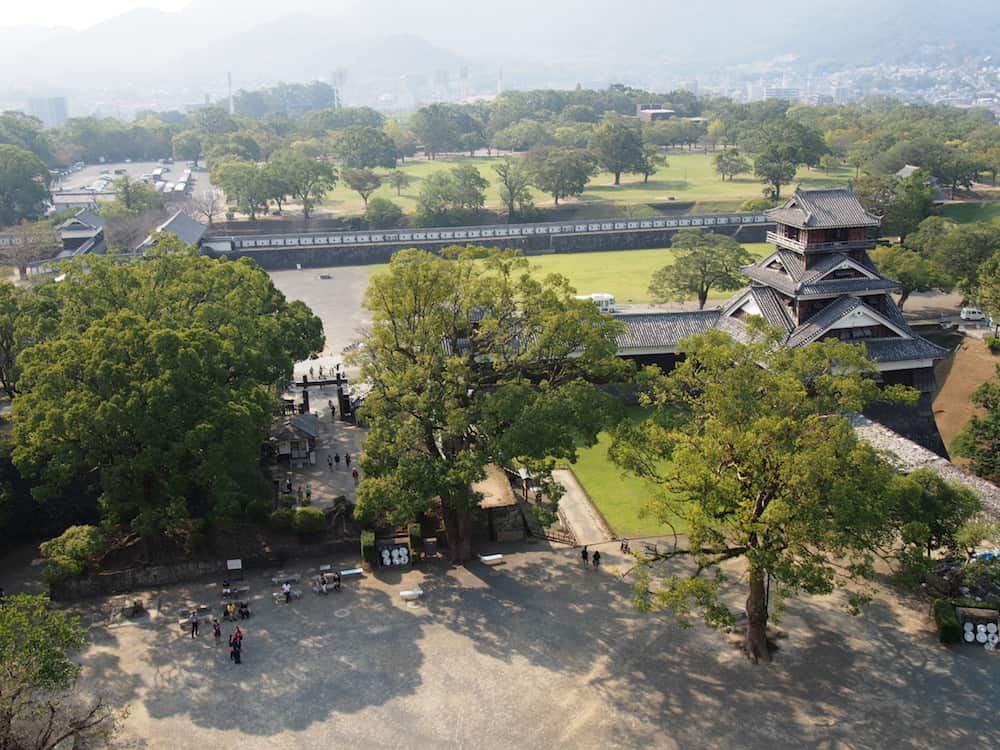
After gazing at the vistas for a while, we descend down the stairs. As expected, it’s much easier going down five stories in the castle.
We hop on to the shuttle bus and head to our next location, the Children’s Culture Center, a government-funded centre that’s open to tourists. This three-storey building is full of free activities for children and families to enjoy. The staff at the centre are friendly and welcoming even though they don’t speak much English.
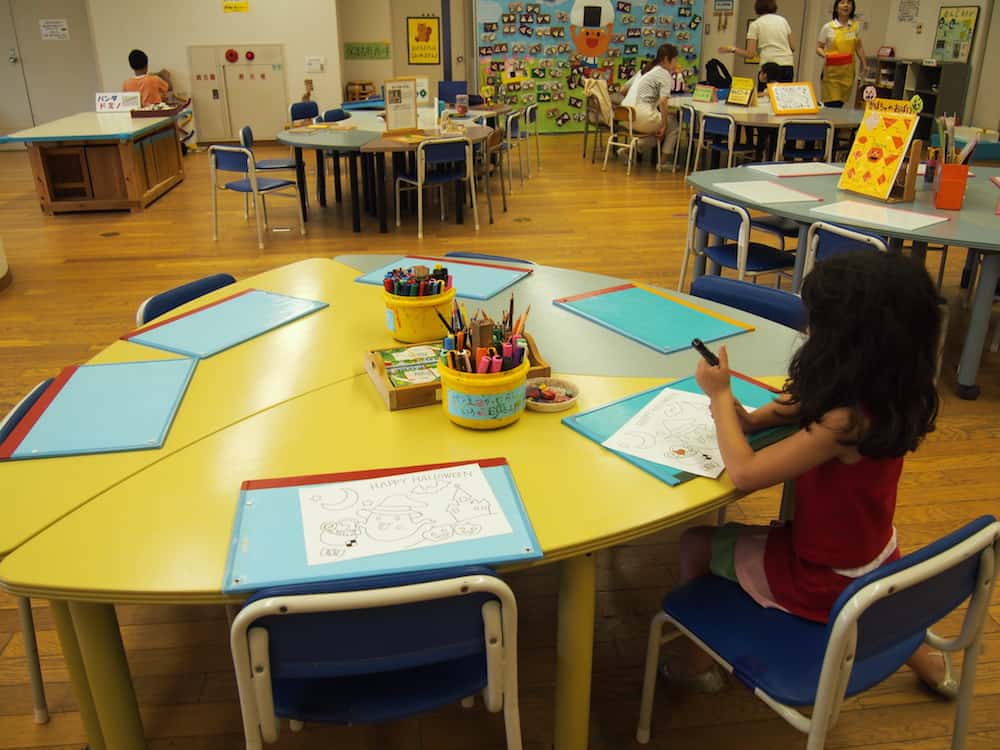
They explain that all of the activities at the centre are free but we just need to sign in. We soon meet some other Japanese families and they explain they come here often to socialise with their friends. They advise that each floor has different activities.
We start on the ground floor with a soft play area.

It’s then up to the second floor for some play time and then we finish on the third floor with a large play space where kids can do kindergym activities.
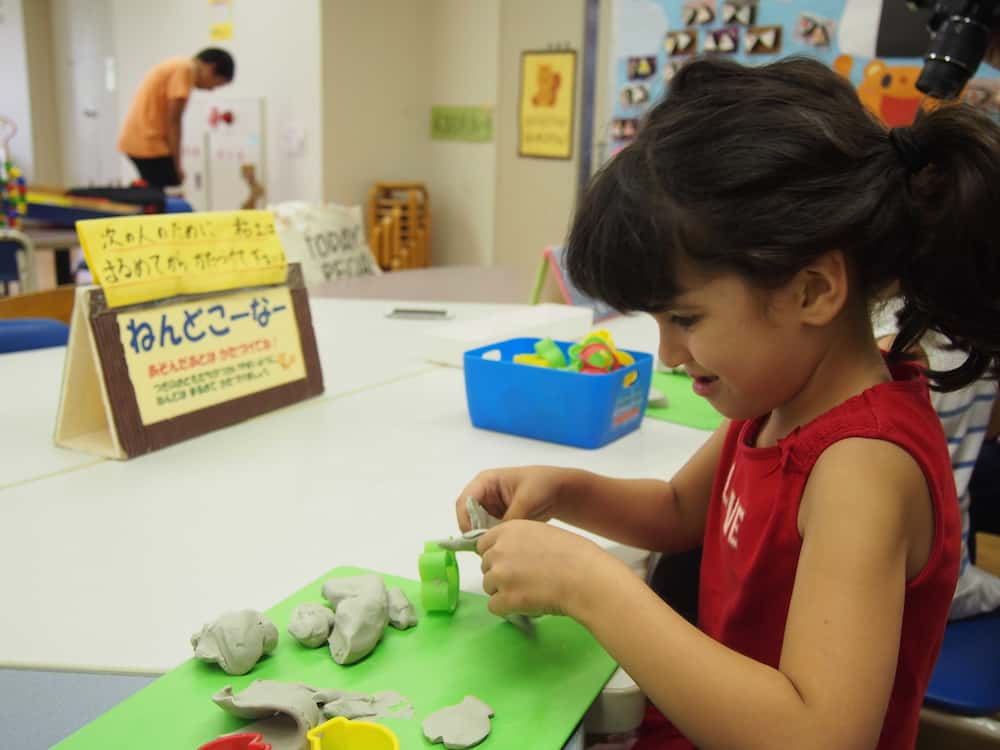
Being a centre for kids, it’s very child-friendly with elevators, kids sized amenities in the toilets and even vending machines that distribute hot food and ice cream.

The closing time announcement then comes over the intercom in Japanese and English and it’s a cacophony of tears as parents try to extricate their kids from this fun place. We say sayonara to our new friends and leave to get back on to the Shinkansen bullet train back to our base in Kagoshima.
The next day, we wake up to torrential rain in Kagoshima. Our plans of strolling around Kagoshima are dashed. It’s time for Plan B. After eating express, we hop on to the Shinkansen bound for Fukuoka, just 75 minutes by train. This is the largest city in Kyushu with over 1.4 million people. We arrive in Fukuoka station to a warm and sunny day. Our destination is Ohori Park.
We ask for directions and we’re advised to take the subway as it’s faster. (Japanese subway systems are easy to navigate with automatic ticket machines and friendly station staff).
Ohori Park is a beautiful scenic park in the middle of Fukuoka and is a great spot to hang out for a few hours. The park surrounds a pond and three islands and features a 2km track around the lake. The large pond was originally part of the moat for Fukuoka Castle. Ohori actually means moat in Japanese.
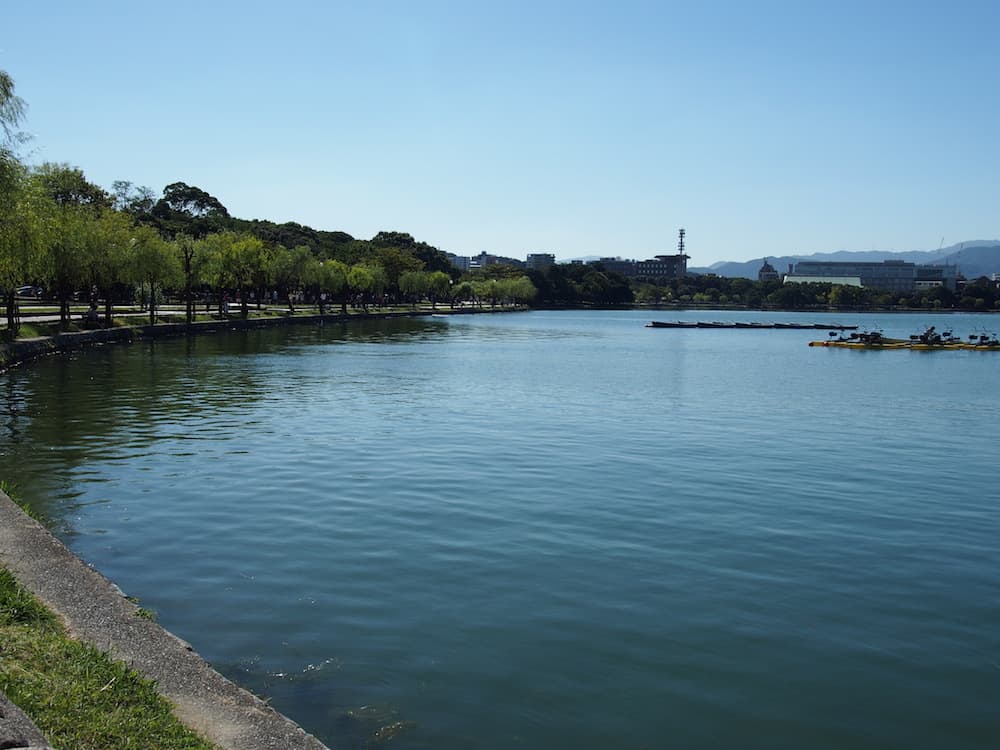
The park is full of walkers, runners, dog owners and families. As we walk around the park, we can hear a saxophone and notice a musician practising in the trees. It’s especially family-friendly with two playgrounds located within the park.
The first playground we visit is for younger tots and is a popular spot for Japanese mothers groups. The playground is full of mums and bubs, many of whom favour baby carriers. It has small play equipment which is perfect for this age.

The second playground is for preschoolers and up and covers a larger area.
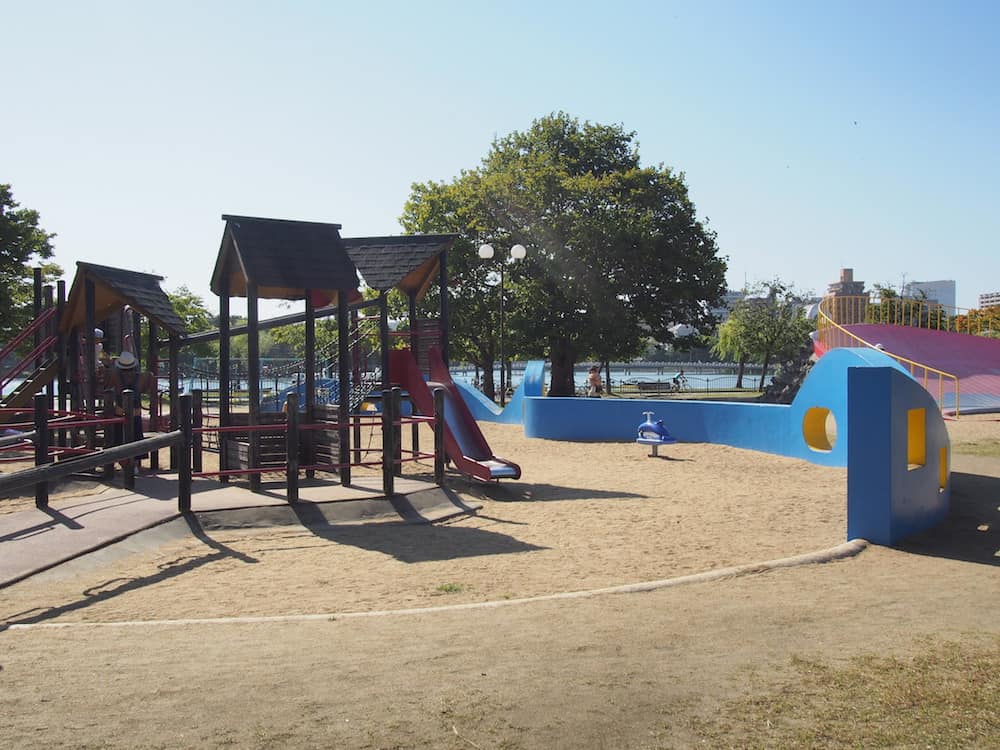
It features your usual playground far such as slides, swing and climbing equipment.
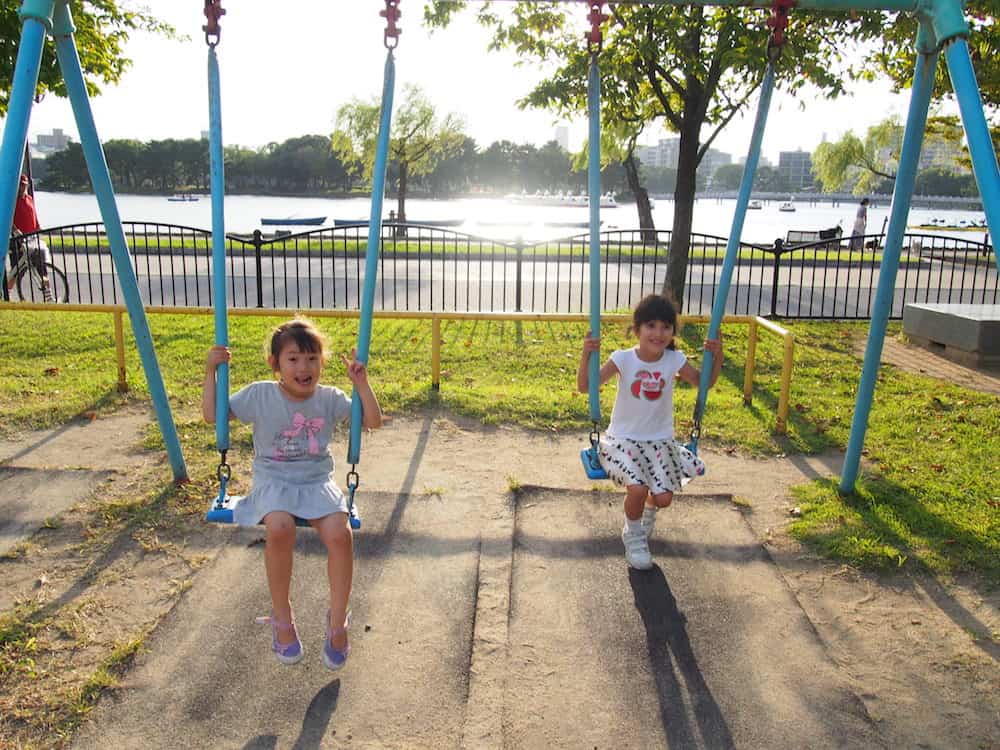
There are lots of kids here and it’s not long until my daughter makes a friend.
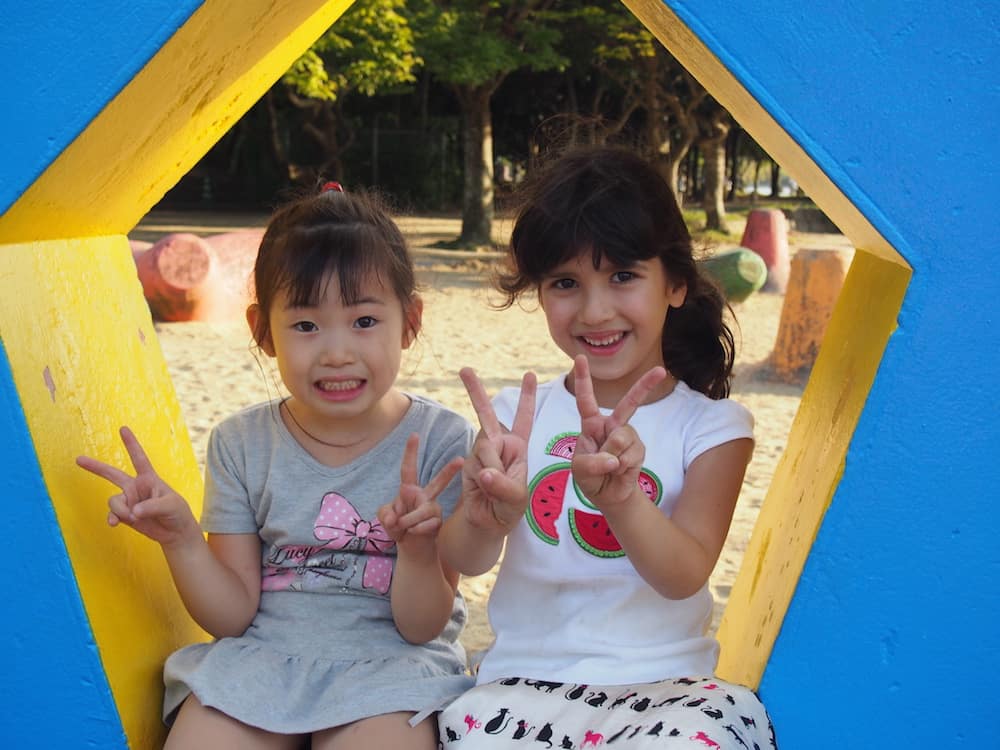
Her new friend shows her how to climb up and slide down the massive concrete bowl.
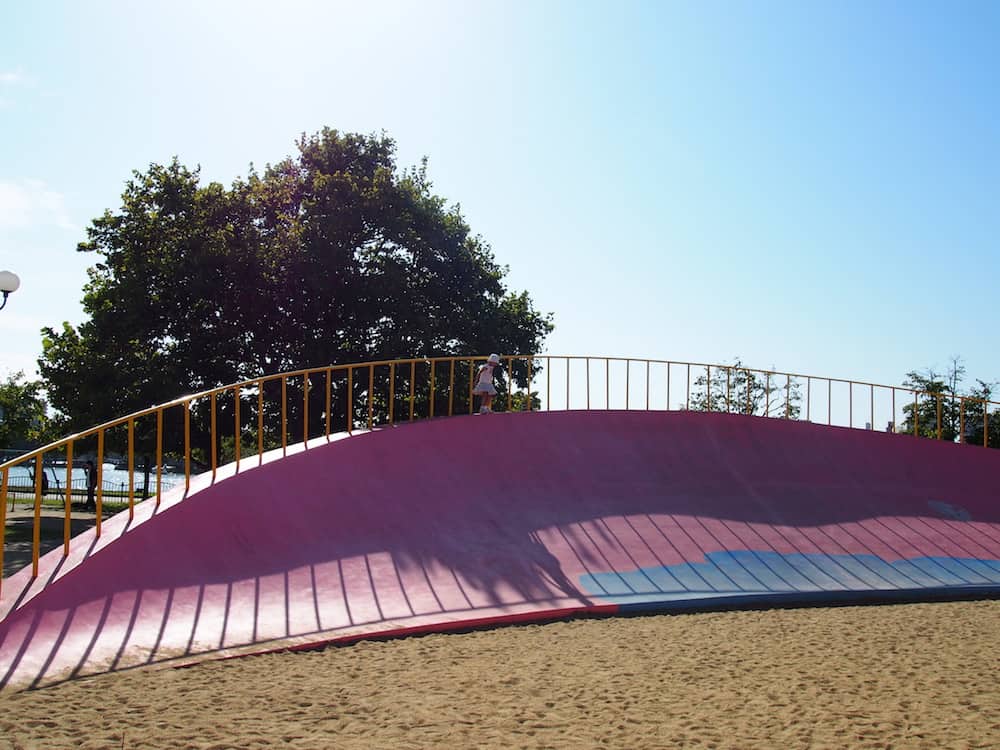
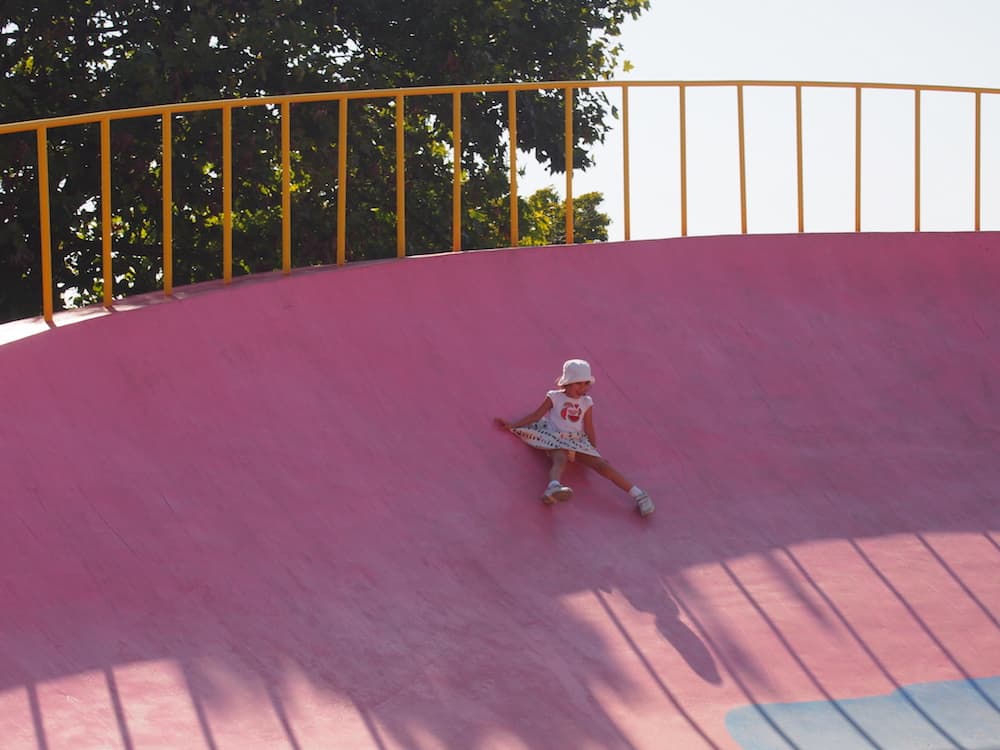
We stop for lunch at the lakeside cafe and watch people paddle giant swans around the lake. You can rent the boats and bikes at the cafe.
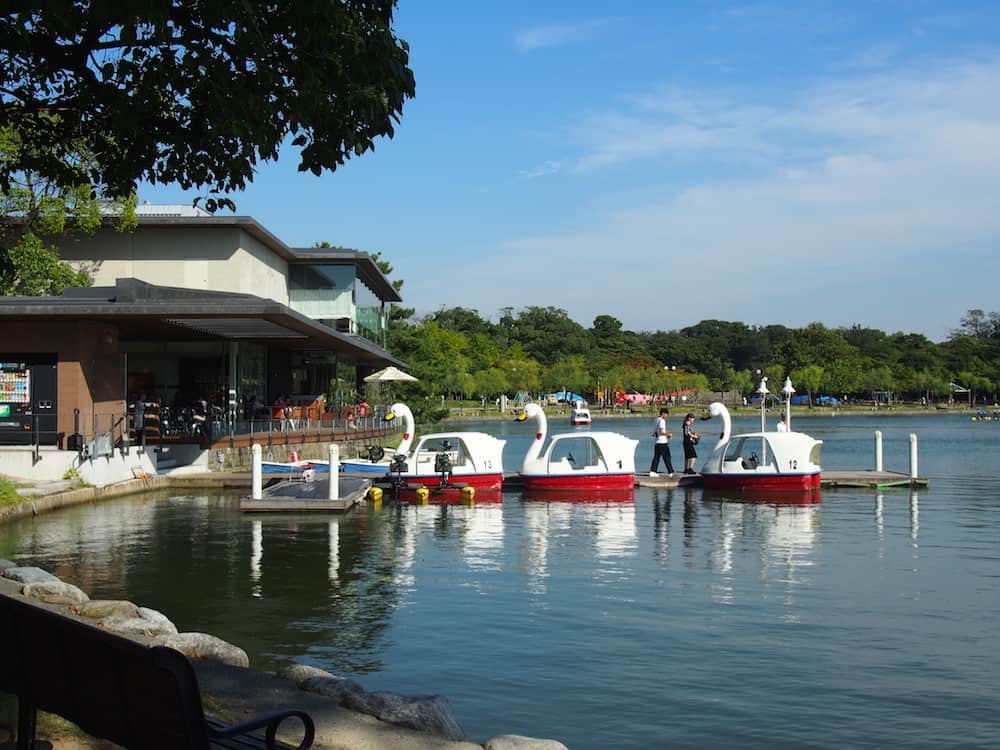
The sun is starting to disappear behind the clouds, so we get back on the shinkansen to a still rainy Kagoshima.
The next day it’s off to Ibusuki. We travel down on another specialty sightseeing train, the Ibusuki no Tamatebako which features large panoramic windows. This train also has a unique feature. Steam known as ‘Dragon’s Palace Smoke’ is expressed from vents at the top of the train when the doors open. This is based on a popular Japanese folk tale.
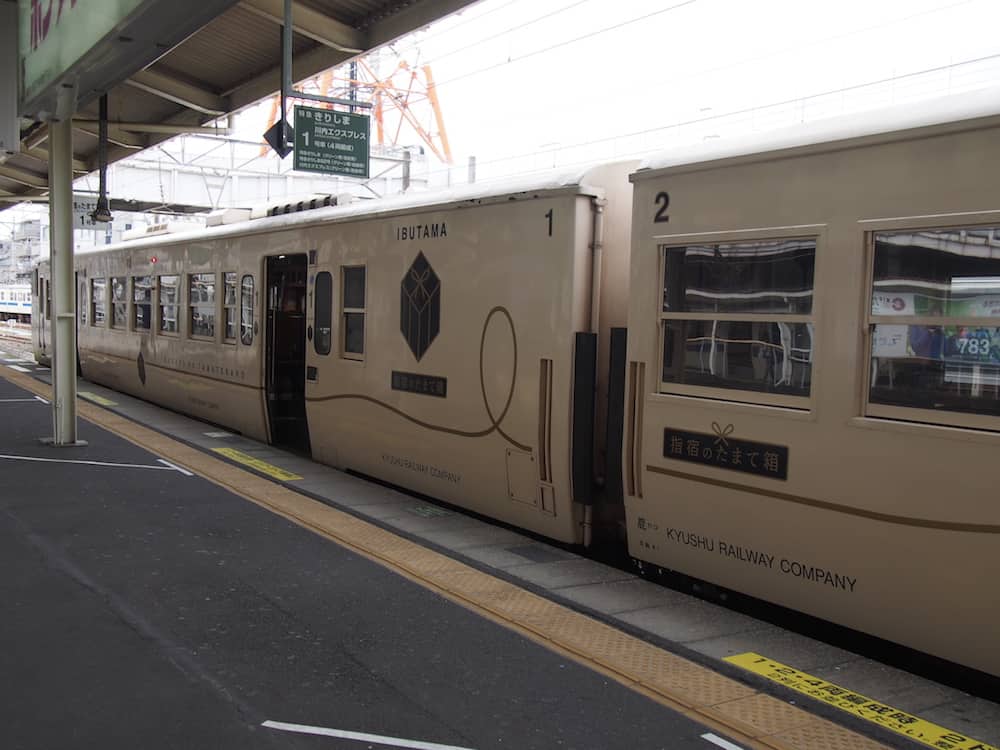
The train hugs the coast as it travels down to Ibusuki with views of Kinko Bay. Ibusuki is famed for its sand baths using hot spring water that bubbles up from the beach at Ibusuki. I’ve arranged a visit to Ibusuki Sunamushi Onsen to experience the natural sand bath for myself.
Here I’m greeted with the instructions for the bath: Go the ladies changing room, strip naked and wear the supplied yukata (cotton kimono) and thongs. Once changed, I follow the walkway outside to the beach and are directed to a shallow hole in the beach. I can see the steam coming off the sandy beach.
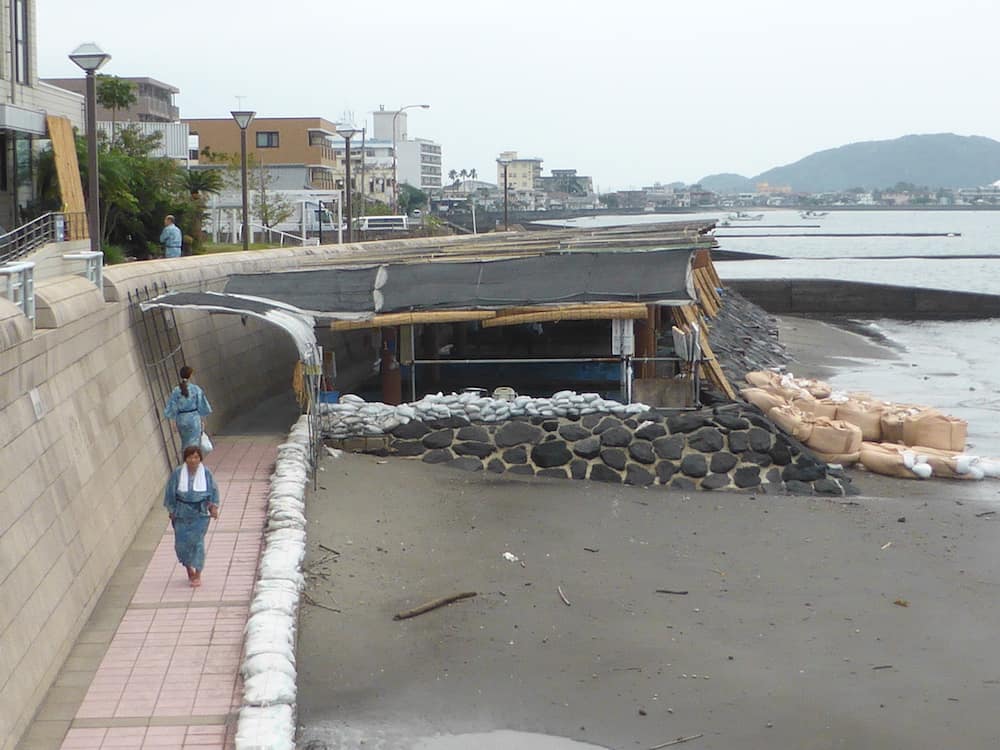
I lie down trying to prevent myself from inadvertently flashing the attendant and place my arms down at the side as directed. He then starts shovelling sand onto me. The sand is hot and heavy and I feel a moment of panic as it does feel like I am being buried alive. The panic subsides and I start to enjoy the experience.
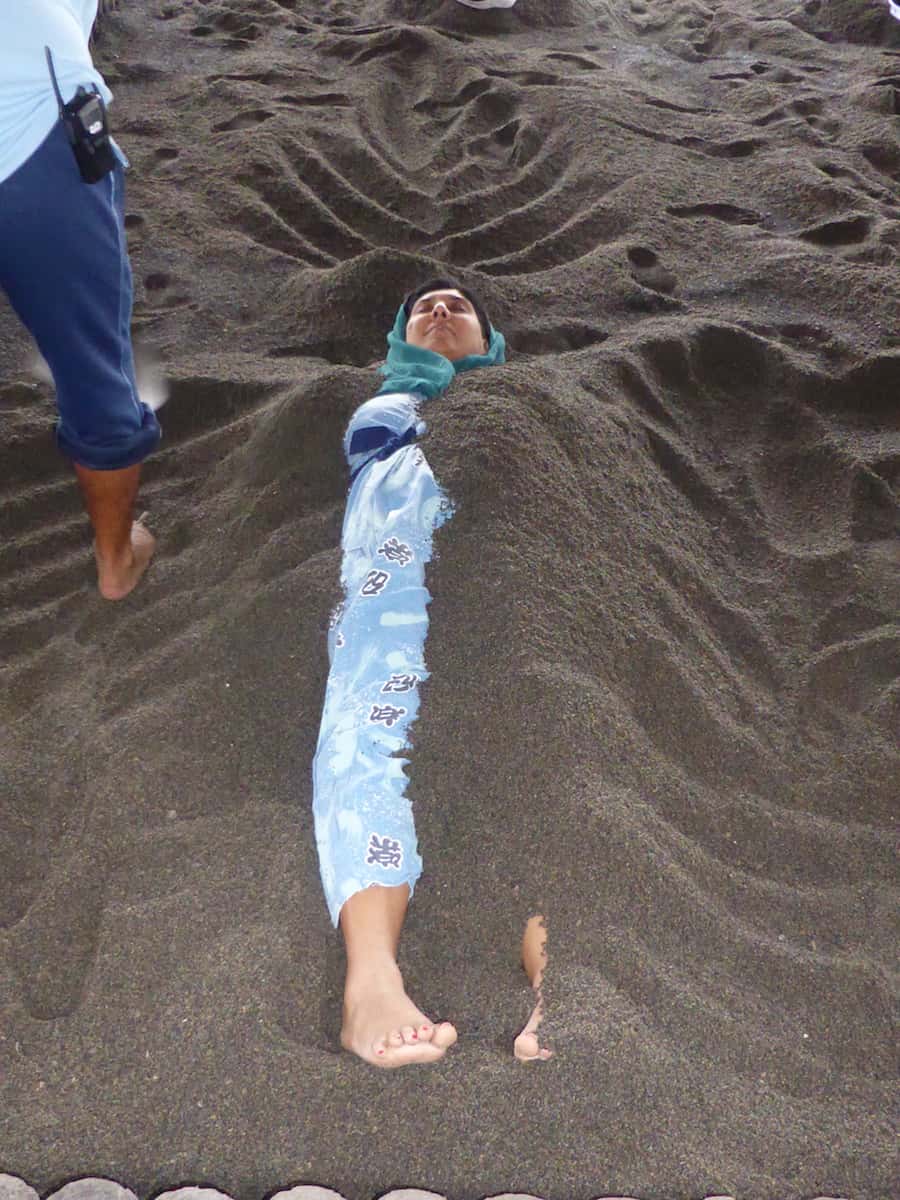
My sand cocoon is warm and relaxing and is reputed to be therapeutic. The composition of the sand is supposed to draw out impurities and relieve conditions such as rheumatism, muscle aches, asthma, diabetes, poor circulation as well as skin ailments.
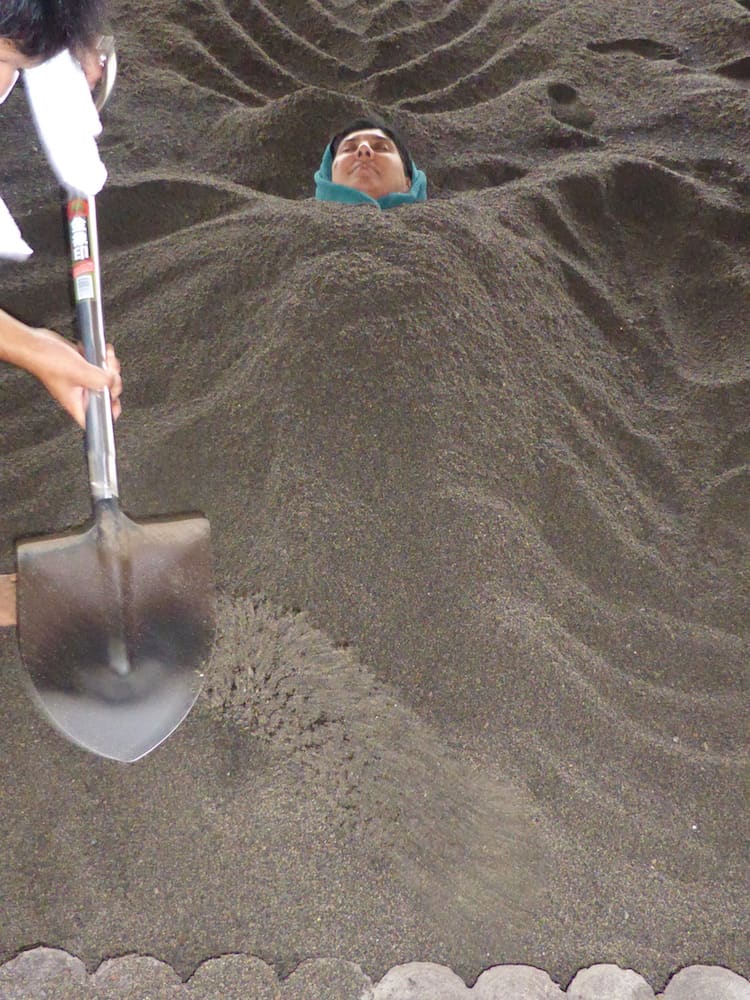
It’s advised that you only remain buried for 10 minutes and the time passes quickly. I move my arms and legs and easily extricate myself from the sand. It’s then back to the changing room to rinse off the sand and soak in the onsen, a hot Japanese pool.
After my therapy, I rejoin my family who have been relaxing near the beach. My husband inquires how I feel after the session. I tell him I definitely feel more relaxed and refreshed. Whether that’s from the hot sand bath or the hot spring bath, it’s unclear but it’s been an interesting experience and I’m keen to catch the train back to Kagoshima to relax more.
The next day, we discover that the weather gods are finally on our side as we wake up in Kagoshima to clear skies. It’s time to visit the volcano Sakurajima which rises out from the bay. Kagoshima is dubbed the Naples of Japan due to this active volcano which regularly blows out ash.
We board a large ferry from Dolphin Bay pier and approach the island looking in vain for the summit of the volcano. In the three days that we’ve been in Kagoshima, we have yet to see the top of the volcano as it is obscured by steam and cloud. Once across, we visit the Sakurajima Visitor Centre which provides us with information about the volcano and the island.

A major earthquake in 1914 killed 35 people and created massive lava flows. More recently, in 2013, the volcano erupted with a plume of ash rising 5000 metres high. Based on seismic data, researchers are predicting a major eruption could occur soon.
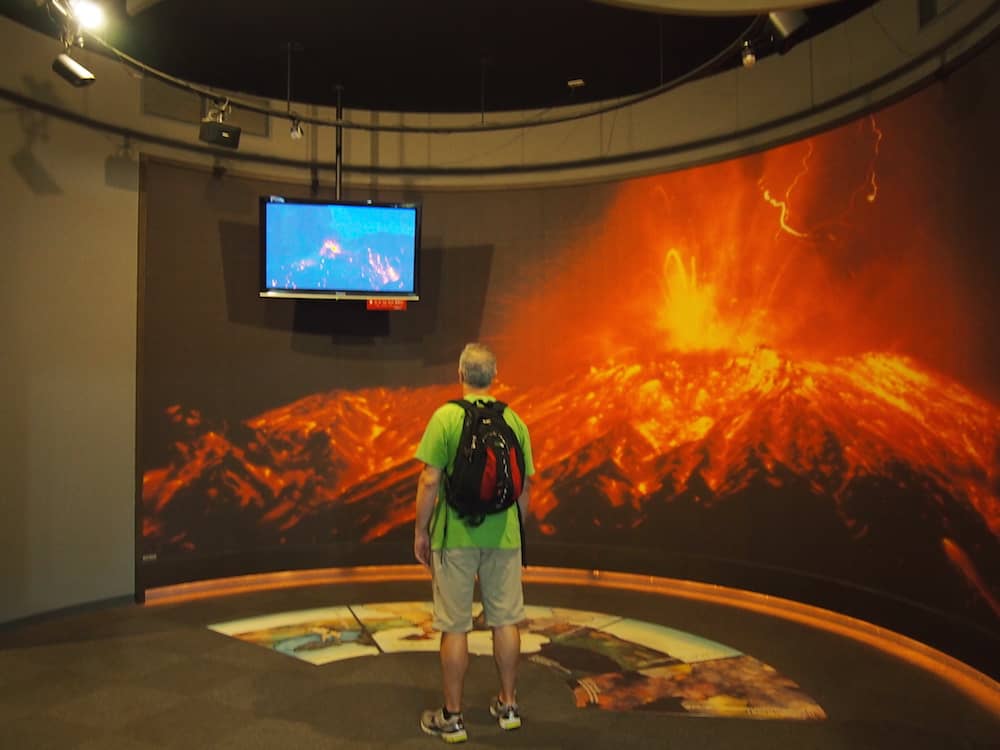
We learn interesting facts about Sakurajima:
- Every house on the island has a concrete shelter.
- Every school kid wears a plastic helmet to and from school instead of a fabric school hat to protect against volcanic ash.
- The volcanic soil of the island yields massive radishes the size of basketballs and tiny mandarin oranges.
There’s also real-time videos and seismic charts which record the volcano’s activity.
We wander out from the centre and board the tourist shuttle bus, the Island View Bus which takes us to various points of interest around the island.
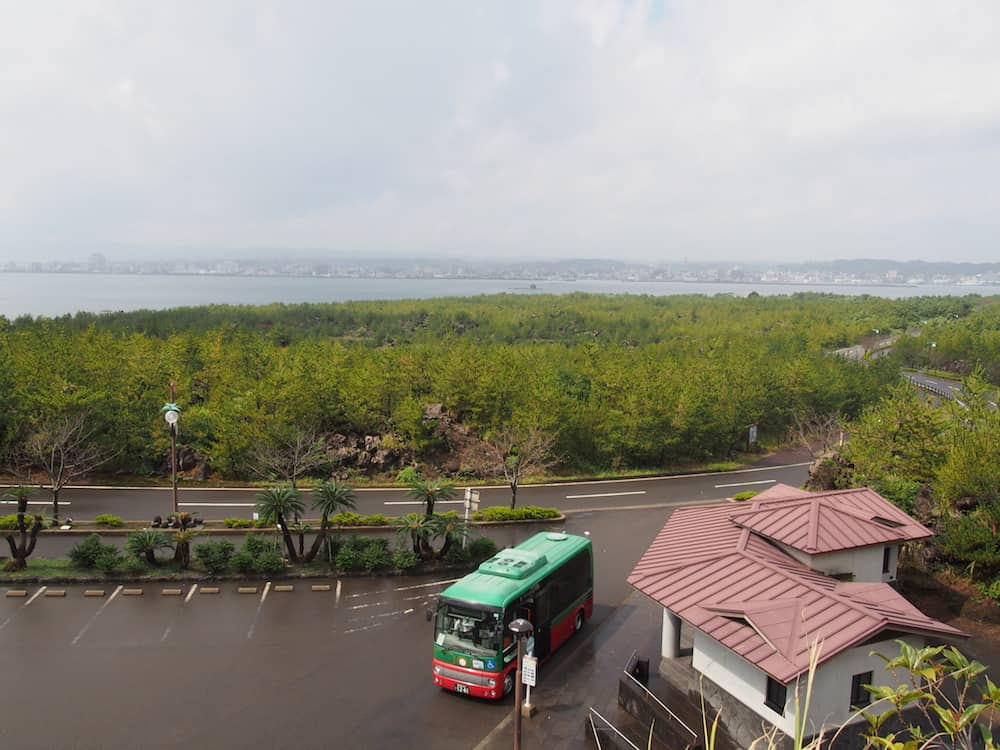
The first stop is Akamizu View Park, a harbourside park with large volcanic rock scattered around. The most notable feature is a large monument of a singer and guitar made entirely of volcanic rock called “Portrait of a Scream”. This sculpture commemorates a massive all-night rock concert in 2004 which attracted 75,000 people,
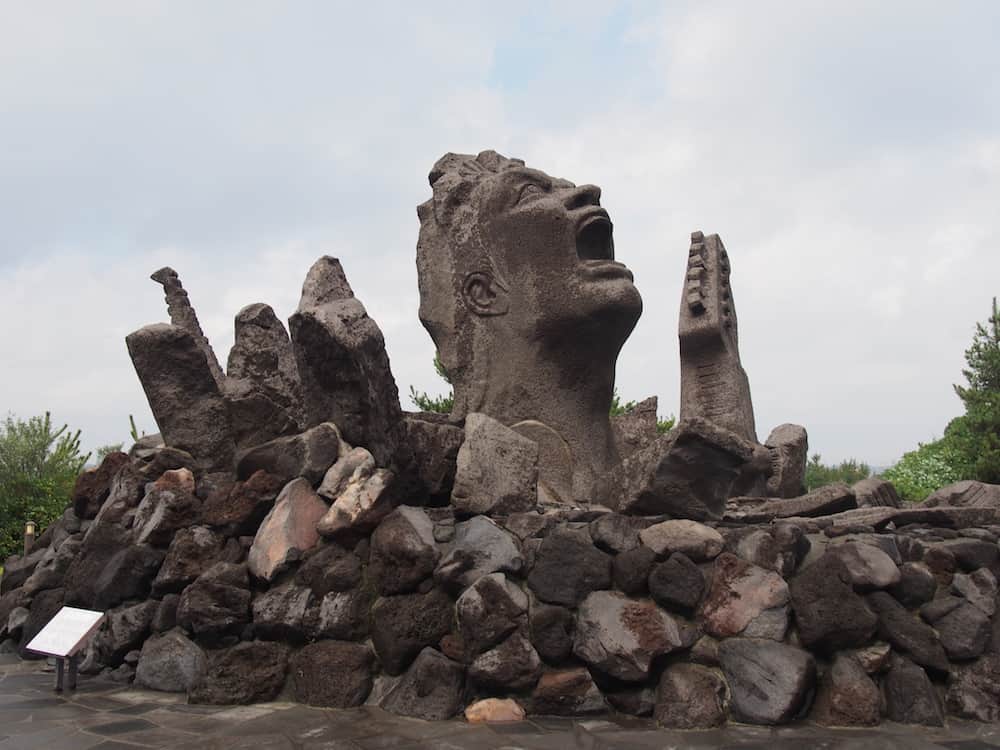
Our next visit is to the Yunohira Observatory station which is the closest that visitors can get to the volcano. Although we’re closer, we still can’t see the top of the volcano as cloud and steam obscures our view.
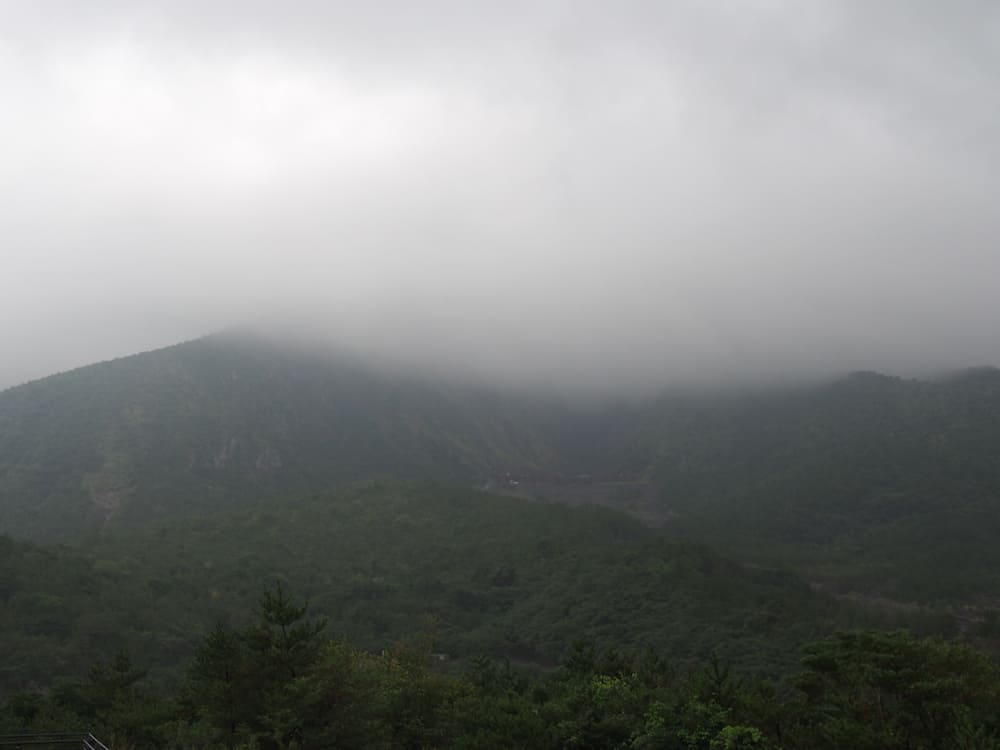
The bus tour ends near the ferry station and we venture to the harbourside Nagisa Lava Trail, a 3km trail through lava fields that were formed after the 1914 eruption.
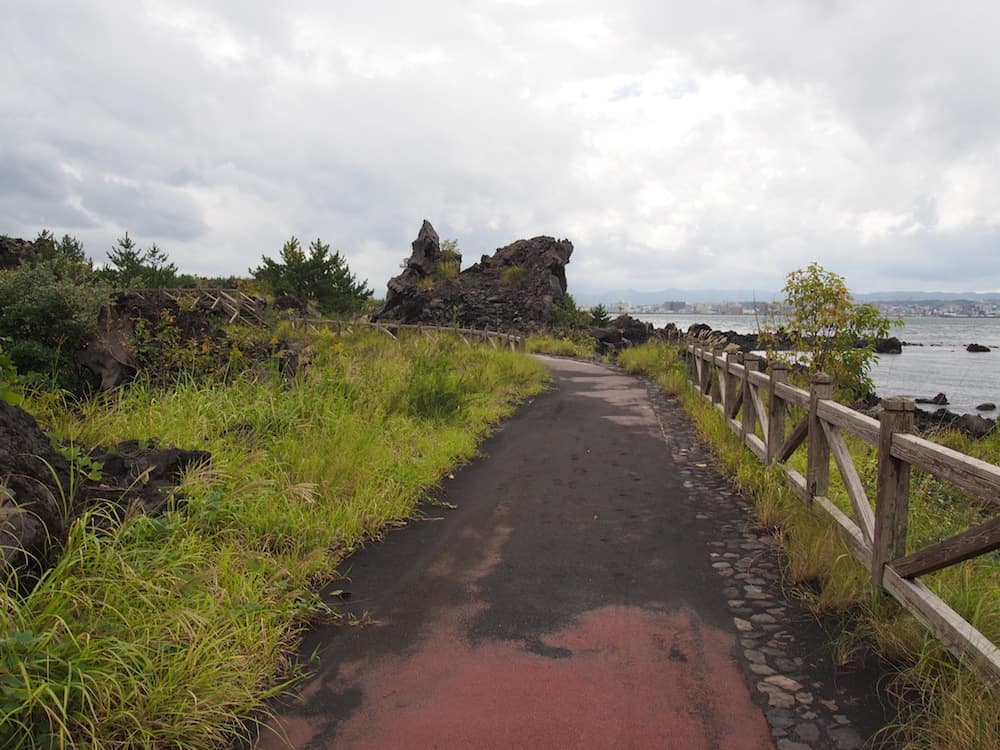
It’s like walking through an alien landscape with black rocks of differing shapes of sizes around us.
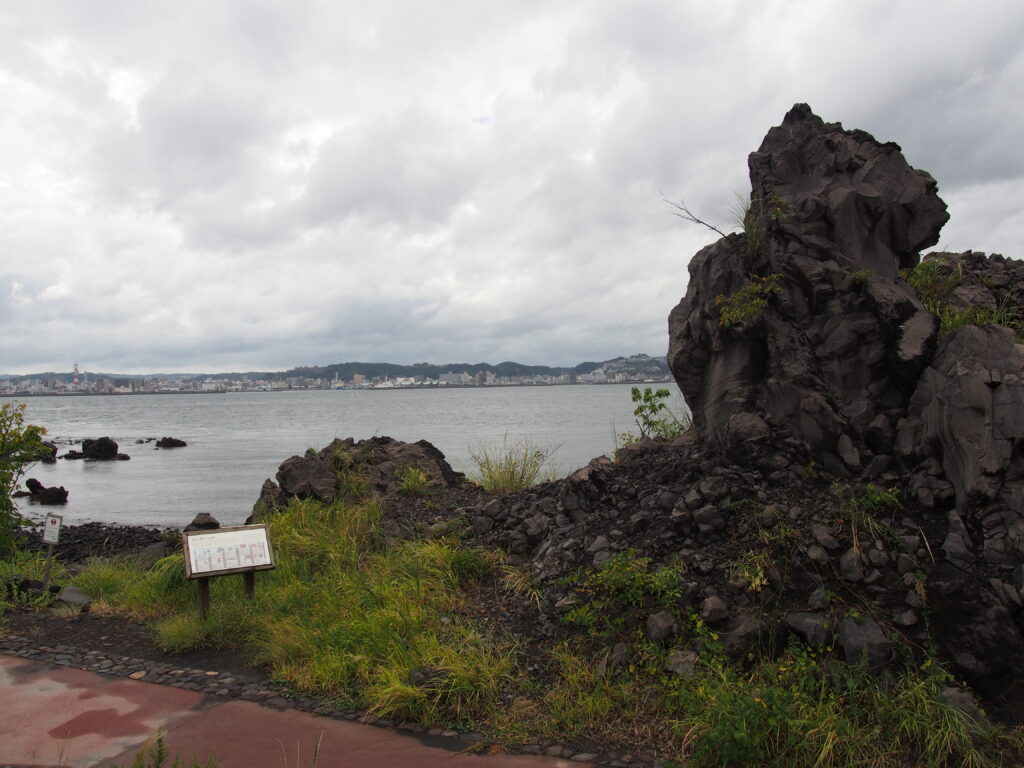
Nearby is a 100-metre long free Nagisa Park Foot Bath which is fed from underground hot spring water.

The weird green-yellow colour is due to the minerals in the water. We submerge our feet in the hot water and it’s heavenly. We rest there for a while enjoying the water while enjoying views back towards Kagoshima and up to Sakurajima.
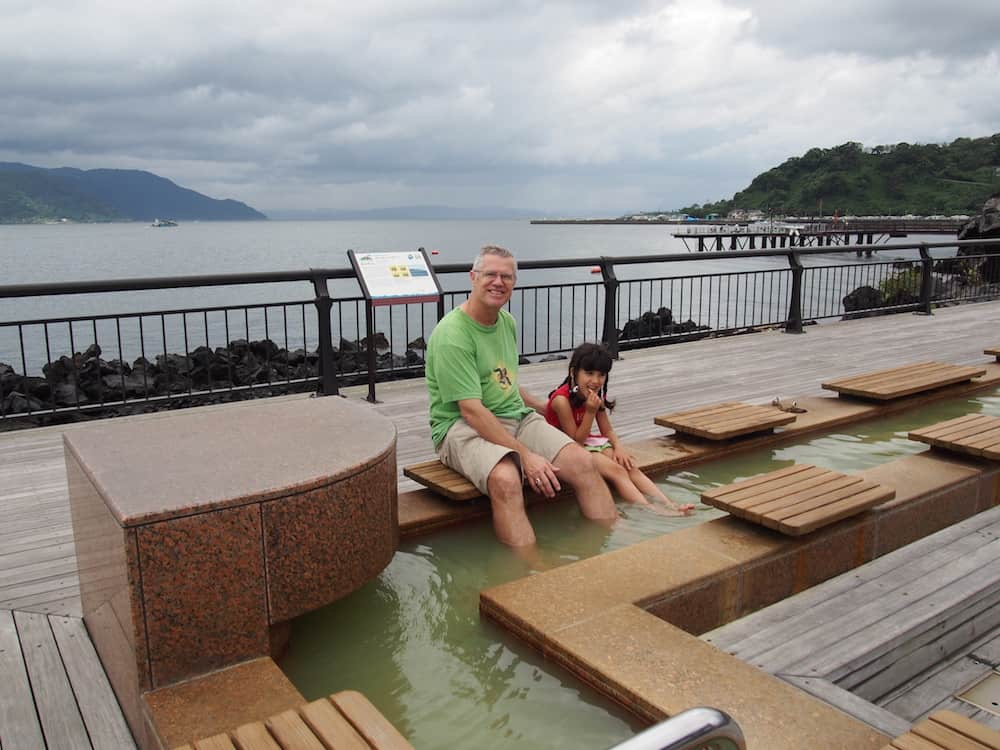
We finish our Kyushu holiday a few days by the beach. A two-hour train ride east from Kagoshima takes us to Miyazaki and then we head out to the northern beaches.
We’re staying in the Holiday Inn Miyazaki resort right on the beach.
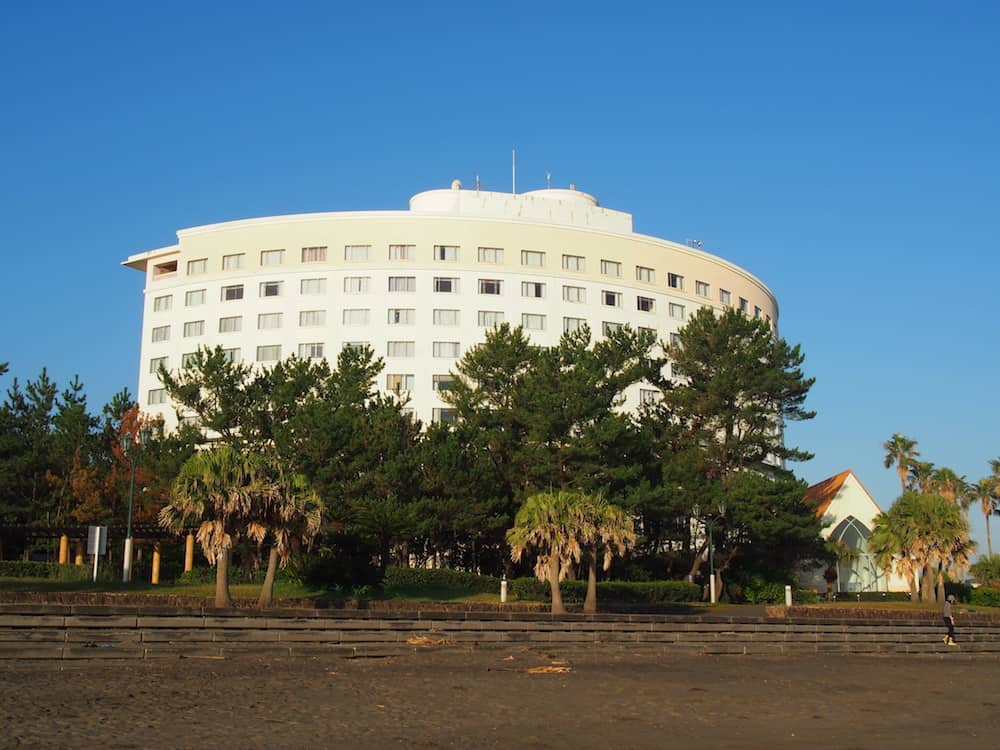
Our room is massive (for Japan) and comprises of a king bed and separate single bed as well as incredible beach and ocean views. It’s slightly retro with a Hawaiian theme but we appreciate the quirkiness.
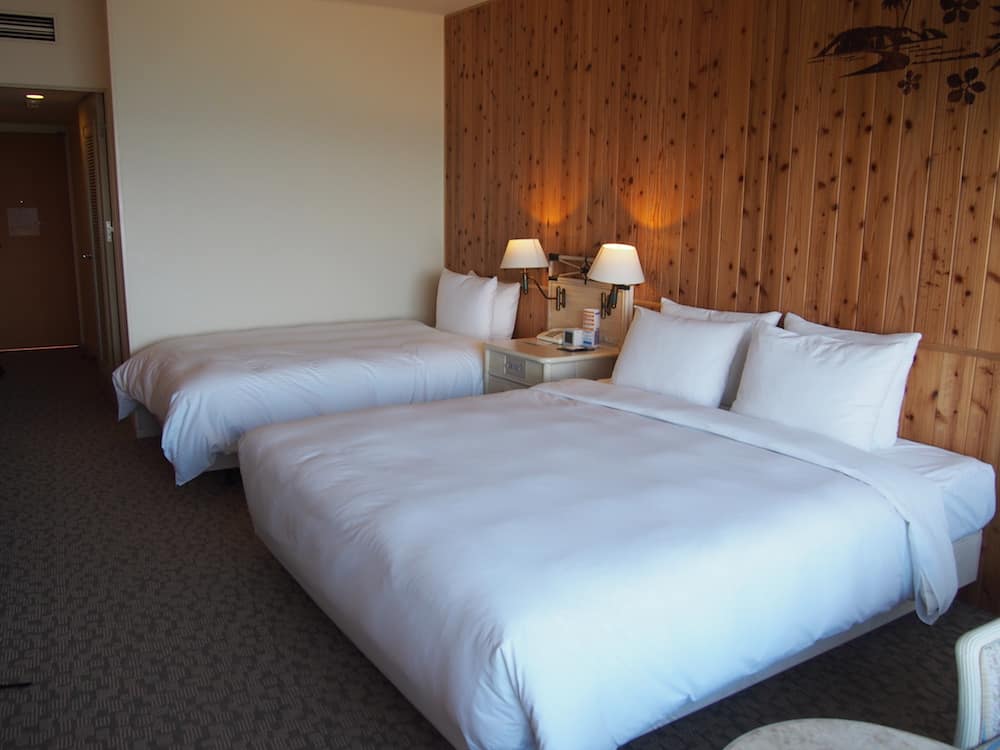
My husband quickly nabs a chair by the window and relaxes enjoying the magnificent views of Aoshima.
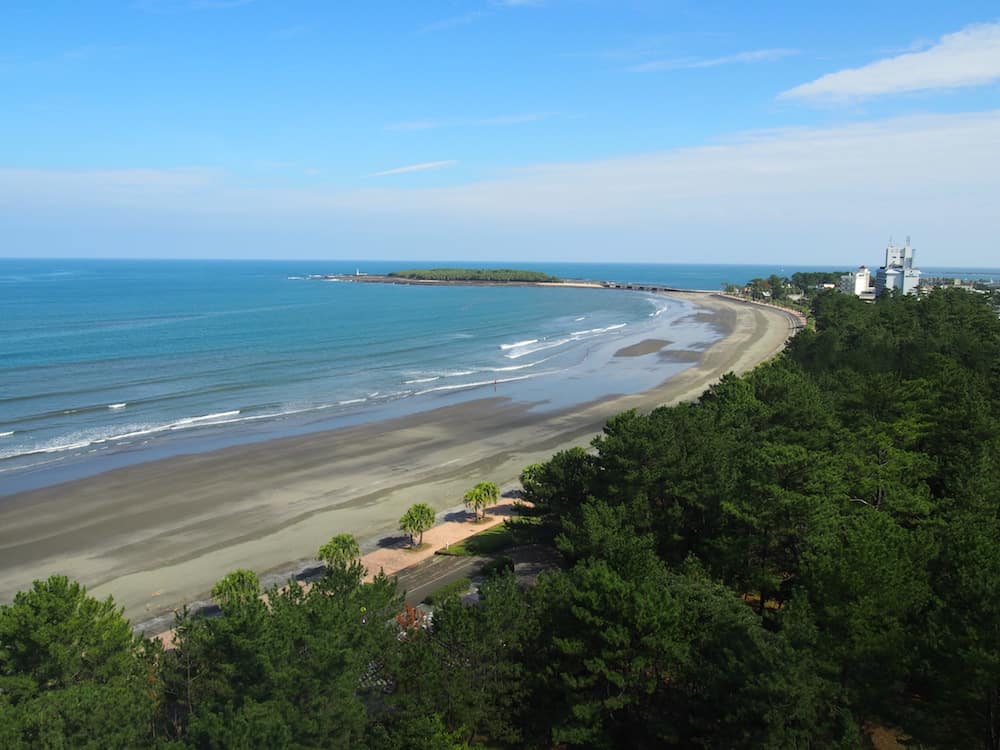
In summer, this resort is a popular holiday spot packed with surfers, swimmers and stand up paddleboarders. We’re visiting in off-season and officially the beach is closed (no patrols) but that doesn’t stop us from swimming at the beach every day. Due to the currents around this area, the water is a balmy 22 degrees with gentle waves.
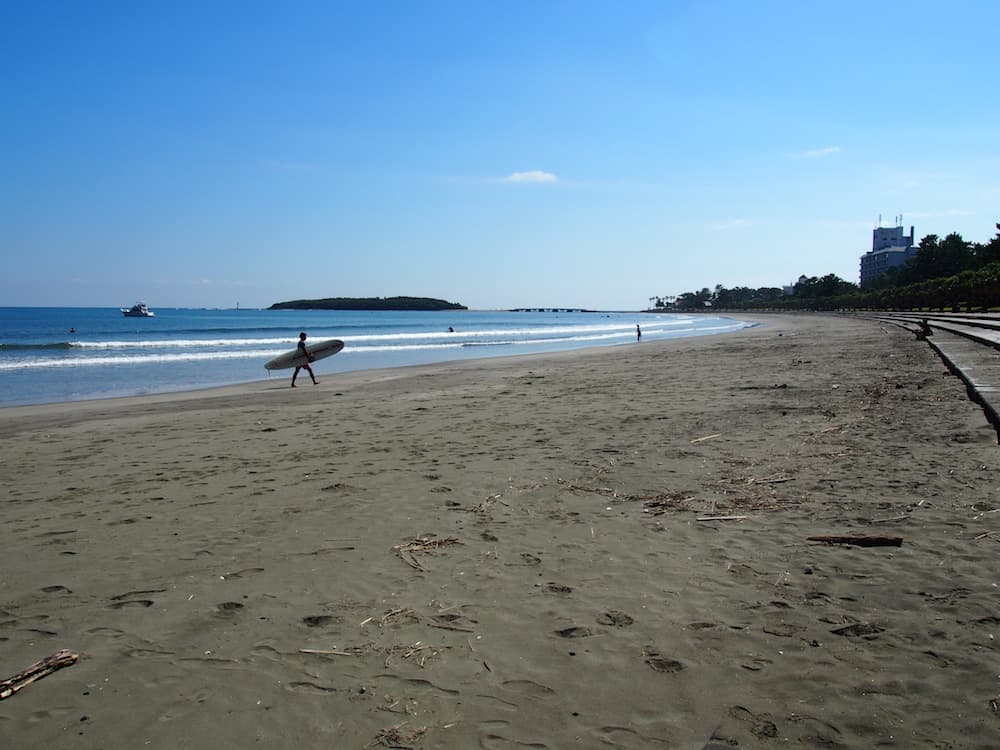
On our way to the beach, we frequently run into wedding parties. As the hotel includes a wedding chapel, we see many brides and grooms celebrating their nuptials.
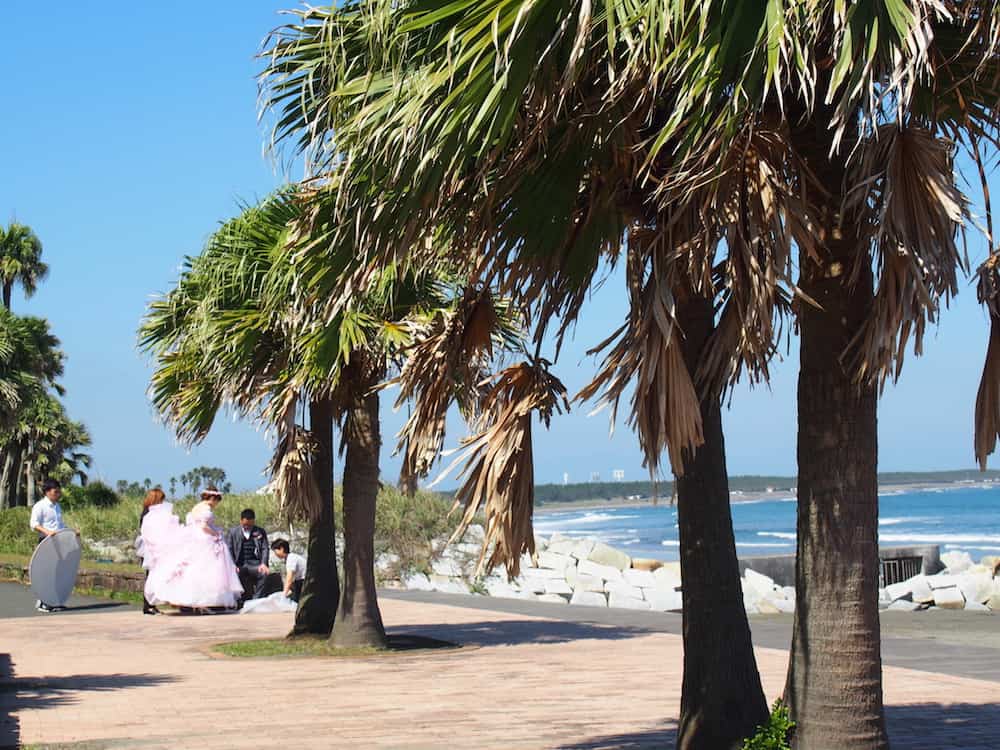
The hotel also includes an onsen, a segregated bathing area with pools of different temperatures as well as a sauna. Visiting an onsen is a daily occurrence for some Japanese and we make it a daily custom. I have to admit it’s an experience bathing nude in front of female strangers.
In between the relaxation, we explore the town and surrounds. It’s a beautiful area.
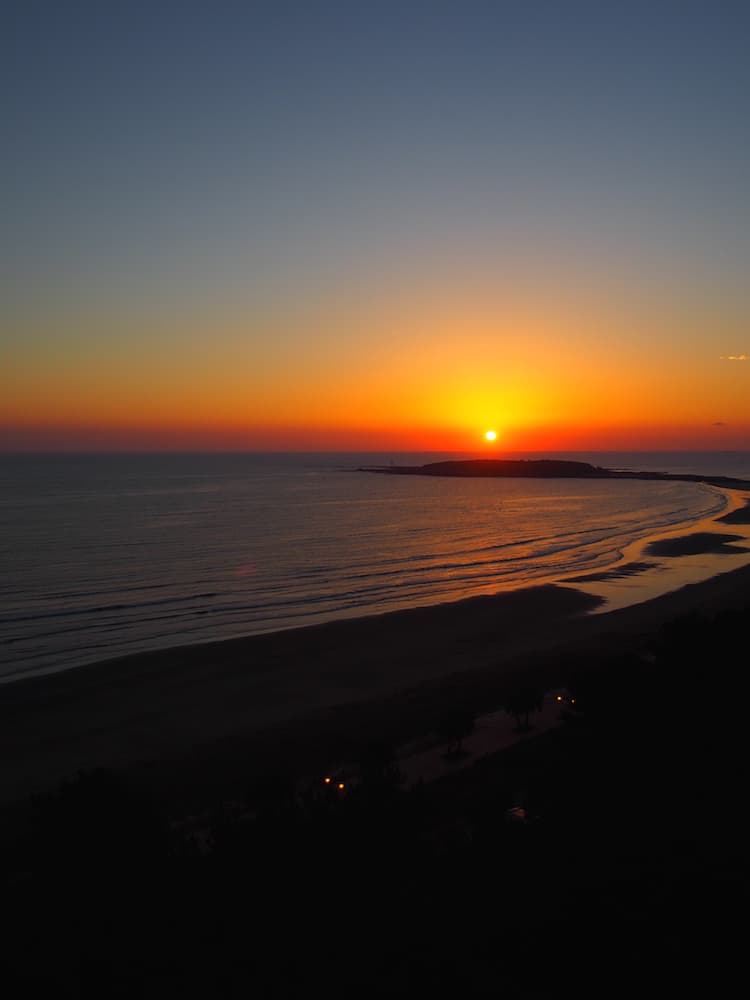
Aoshima is a small island which is connected to the mainland by a bridge.
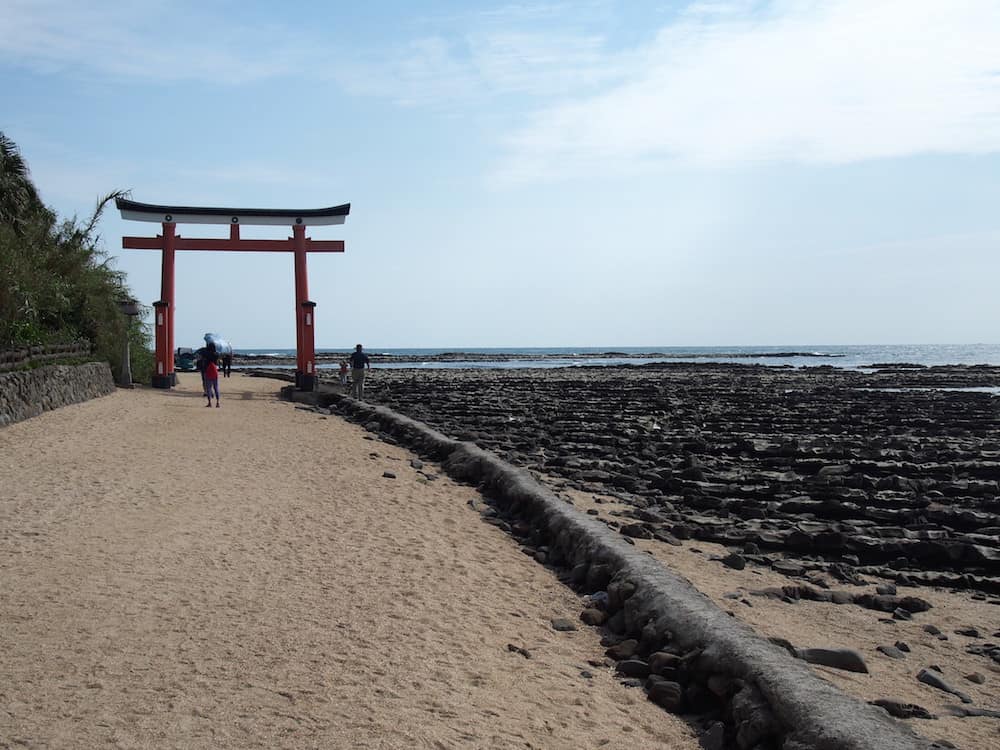
Many visitors come to pray at the Aoshima Jinja Shrine, which is especially popular with newlyweds as praying at the shrine is said to bring luck to married couples.
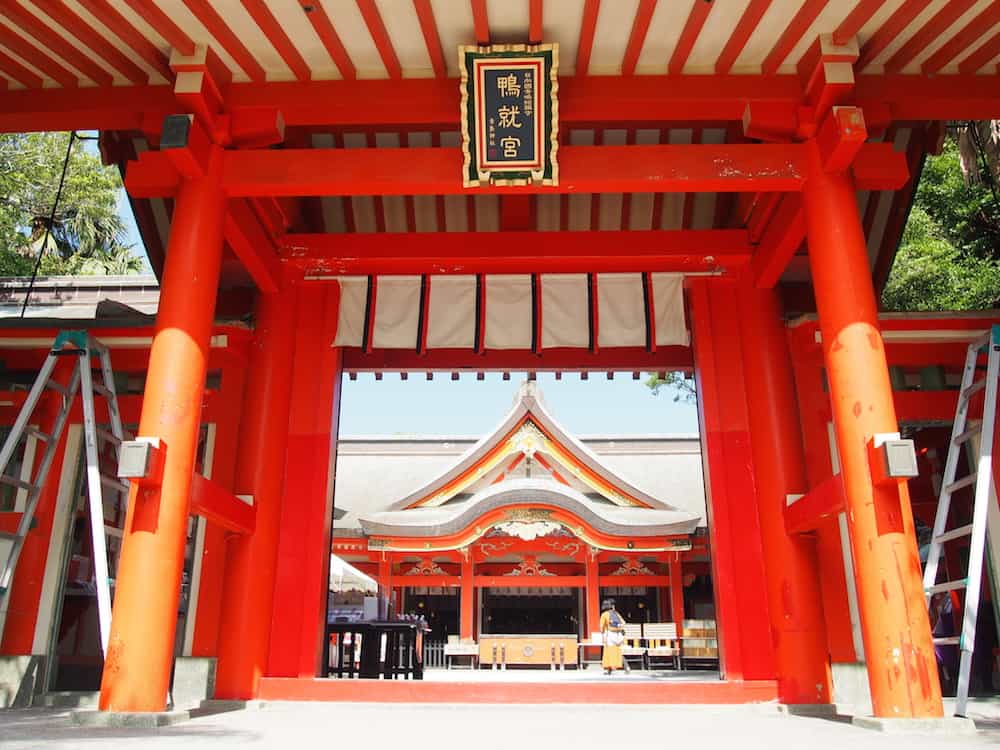
It’s 1.5km walk around the small island and during low tide on Aoshima Island, you can see the geological formations named the Devil’s Washboard. This is a series of straight, basalt rocks which look man-made.
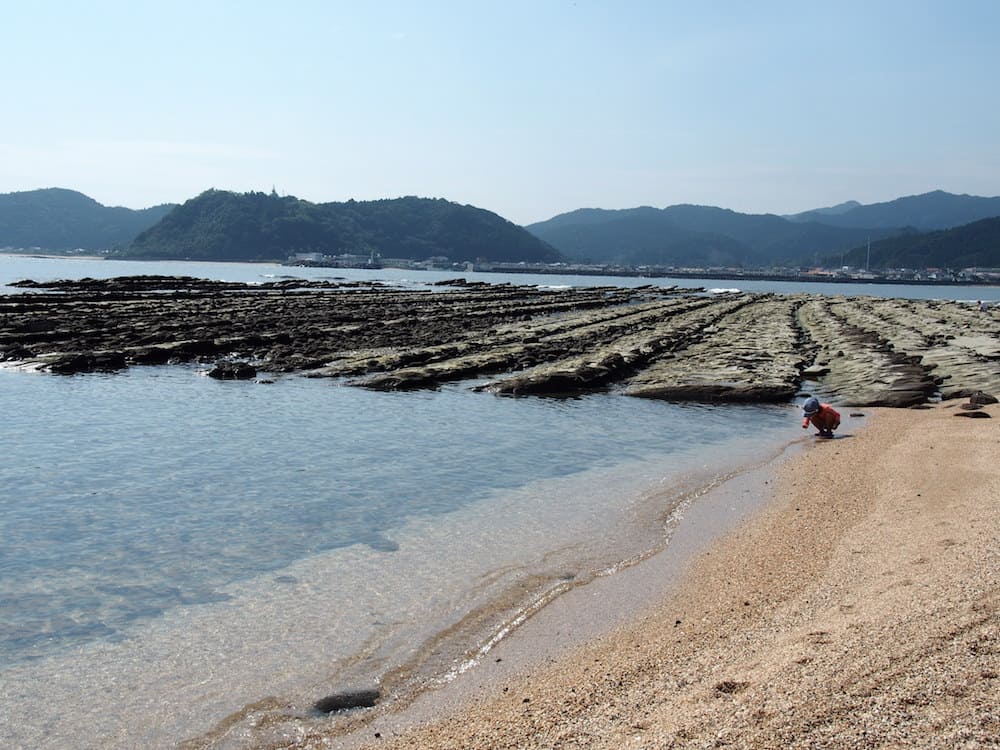
Another day, we catch the local bus and visit Udo Shrine 30 minutes away.
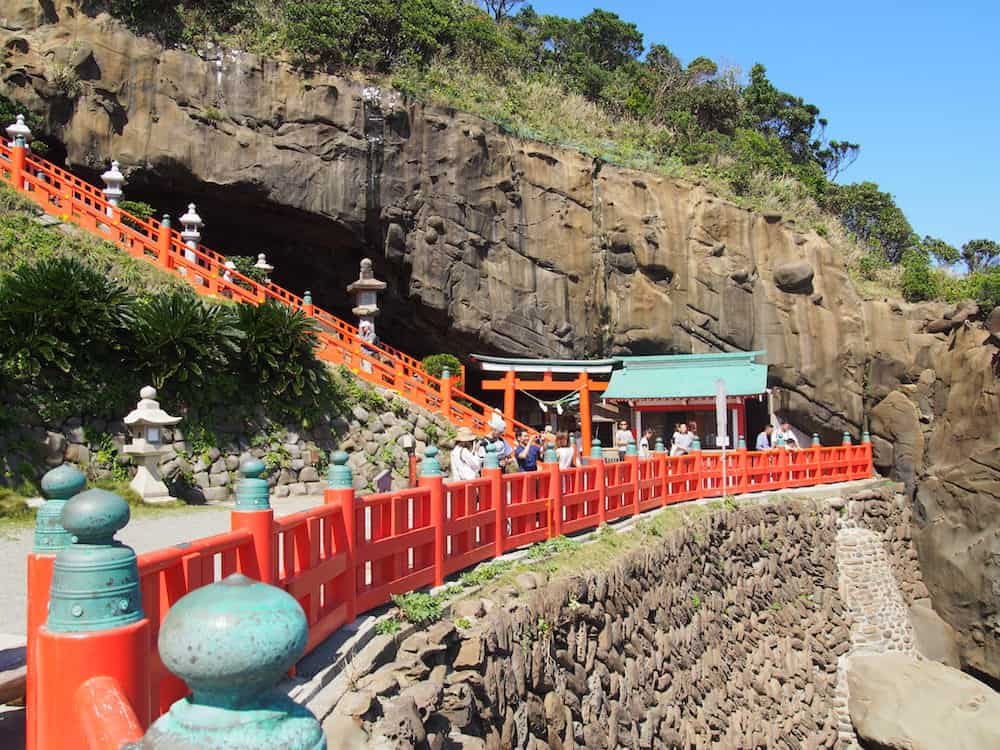
This colourful shrine is situated in a cave near to beach cliffs and is supposed to be lucky for couples and newlyweds. In fact, drinking the water that drips from the rocks is thought to help with conception, pregnancy and birth.

Outside of the cave is a clifftop terrace. From here, visitors throw ceramic lucky balls below hoping to reach a target marked by rope. The lucky balls are available to purchase at the shrine for 100 yen for 10 balls.
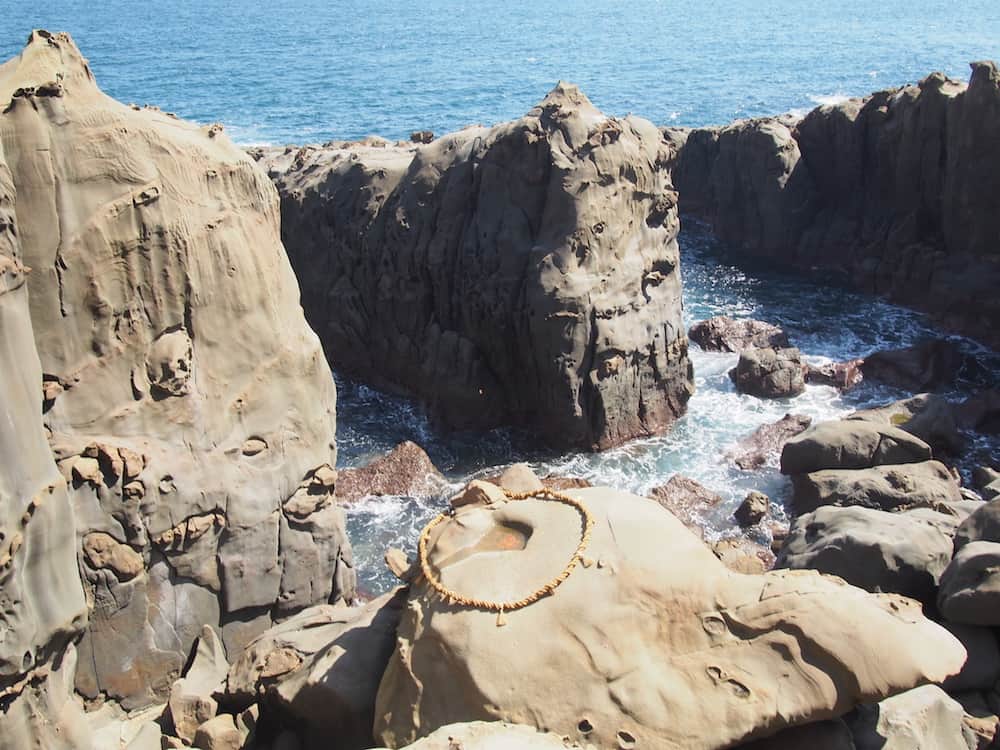
If your ball lands in the ring below, you’ll receive good luck. Women are supposed to throw with their right hand while men throw with their left.
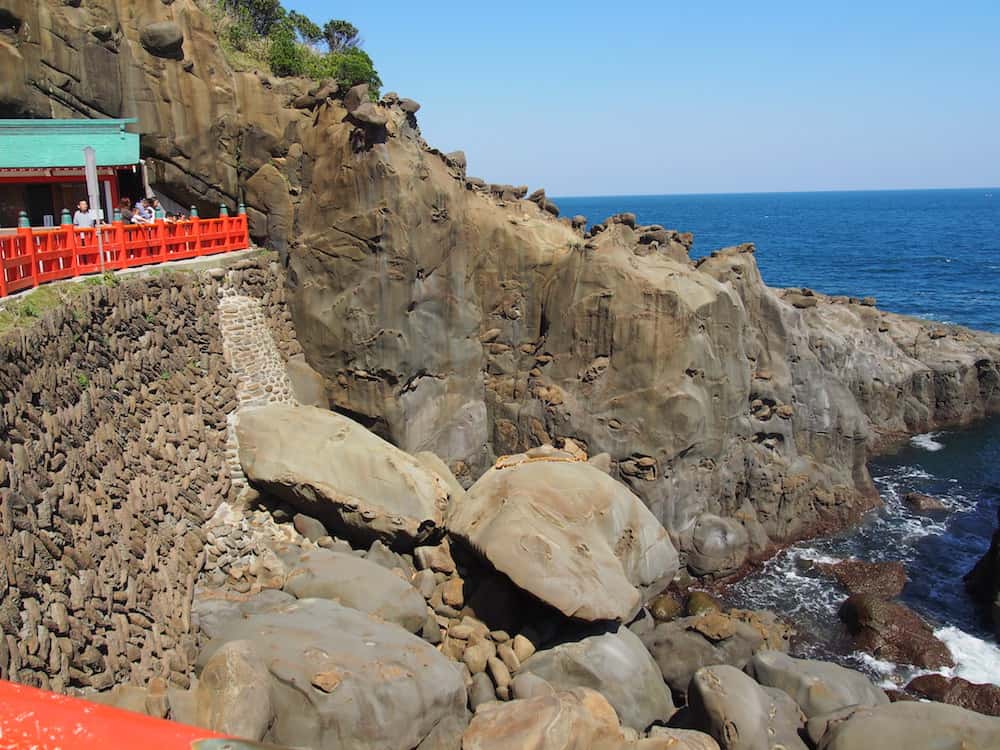
We purchase a few dozen balls and have fun throwing them off the cliff. Unfortunately, none of our balls land in the ring but we considered ourselves bestowed with plenty of luck.
After all, we’re enjoying a fabulous family holiday in Kyushu!
For more Japan family holiday information, visit my articles about our visits to Kyoto and Hiroshima
USEFUL INFORMATION
Getting There
It takes 8 hours to travel from Tokyo Station to Kagoshima Station with a transfer of trains at Shin-Osaka station.
I highly recommend that you you purchase a Japan Rail Pass (only available outside Japan). Available in durations of 7, 14 and 21 days, it’s a cost-effective way to travel around the country using JR train network. You can use it for all JR trains (excluding the superfast Nozomi trains) and JR ferries. There are two classes, Green (First class) and Ordinary.
We purchased Ordinary tickets and found them to be excellent. Kids 6 and under travel free on the trains. In 3 weeks travelling around Japan, we never once reserved a journey on the Shinkansen. Instead, we would arrive at the station and line up at the unreserved carriage area of the platform. This is ideal when you are traveling with children as you never have to stress about missing a train.
Make sure you bookmark the website Hyperdia as it contains train schedules and is indispensable in planning your trip.
Where to Stay
In Kagoshima, we stayed at the JR Kyushu Hotel Kagoshima in a Twin Room located within the JR Kagoshima train station. (JR Hotel Group, a subsidiary of Japan Rail, own and manage numerous properties around Japan adjoining train stations. They offer comfortable rooms and there’s discounts for JR Pass holders). Also adjoining the train station is a large shopping centre AMU Plaza with department stores, restaurants and grocery store. I’m in heaven when I find a Uniqlo and GAP stores.
In Miyazaki, we stayed at the Holiday Inn ANA Resort Miyazaki.We had a wonderful beach break at this hotel. Sign up to the IHG Rewards Club to earn points on your stay.
Getting Around
Getting around Kyushu, use a JR Rail Pass.
In cities like Kumamoto, Kagoshima and Sakurajima, there are tourist buses that take visitors around to designated sightseeing spots. All are reasonably priced. In Fukuoka, the subway is convenient and easy to use as well as the local bus system.
Eating Out
Kagoshima-Chou Station is next door to the AMU Plaza which is full of department shops, boutiques and eating places. We breakfast every day at Seattle’s Coffee and for dinner, just choose one of the many restaurants within the shopping complex.
We visited Kyushu prior to the pandemic. However, this article has now been updated with current information.
